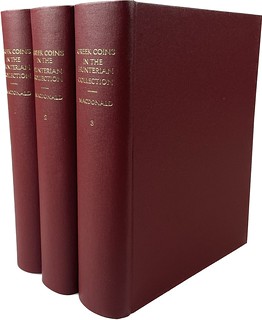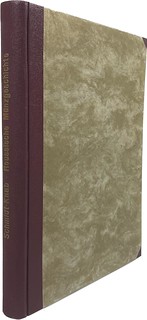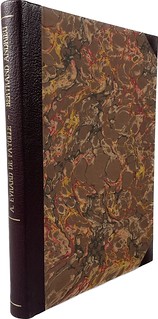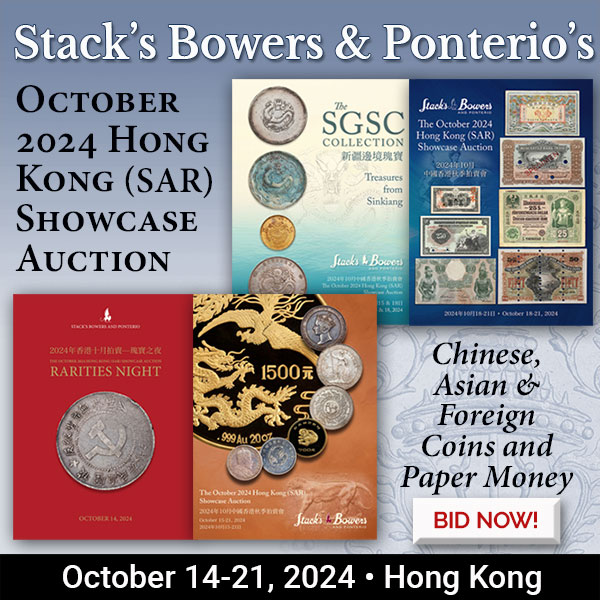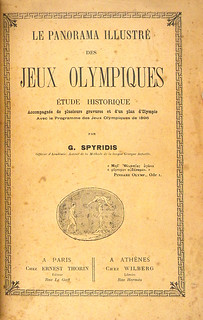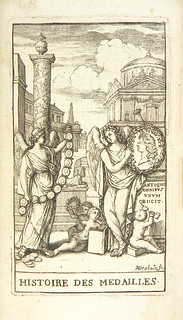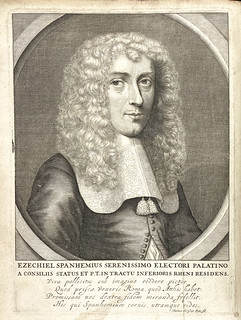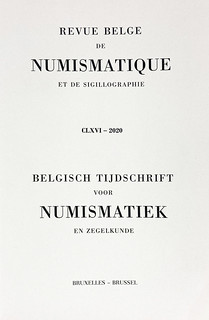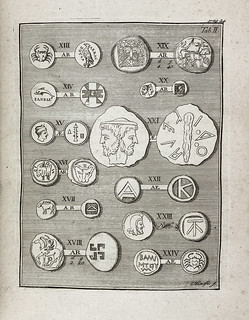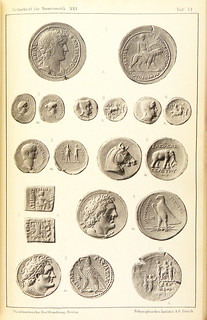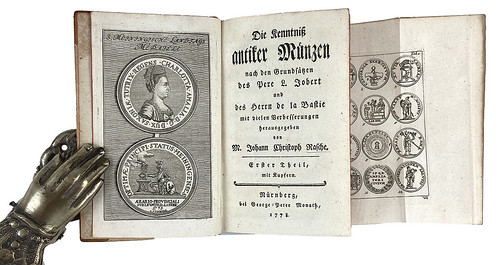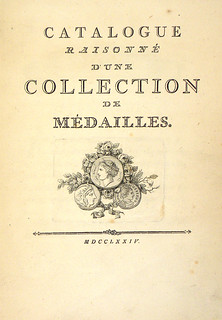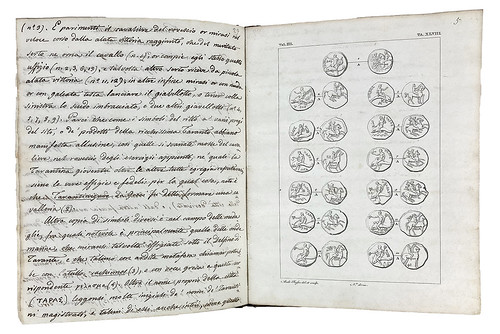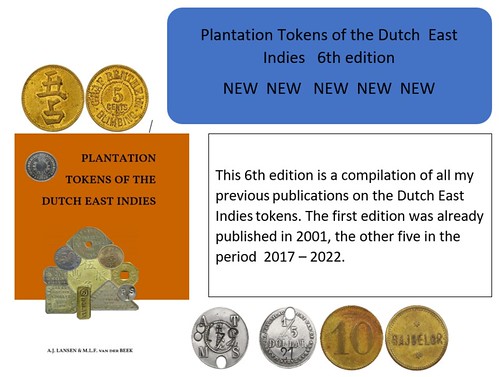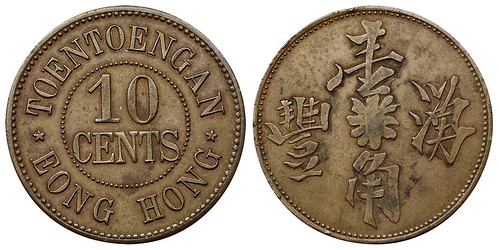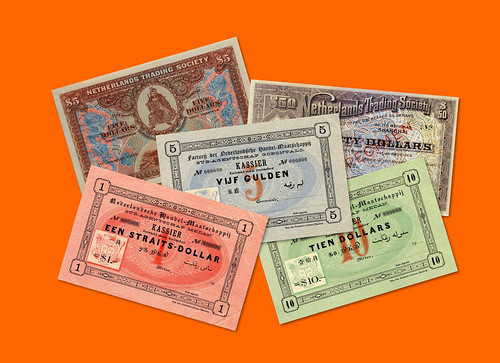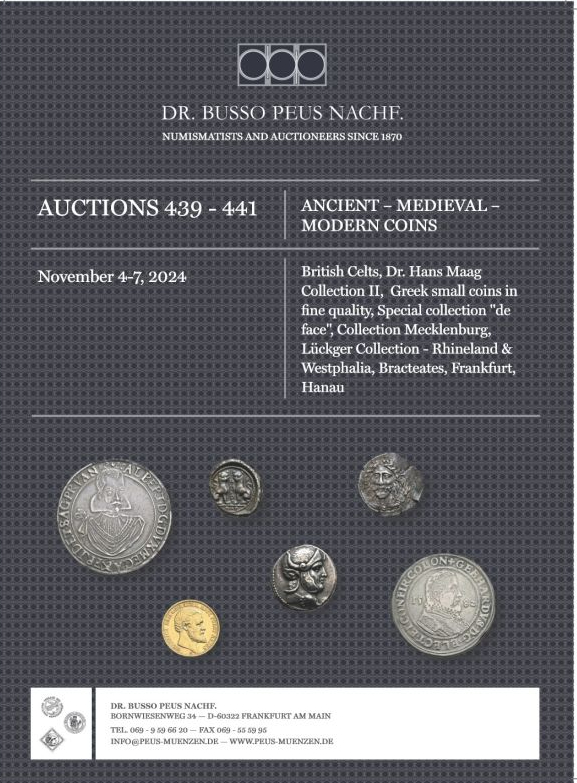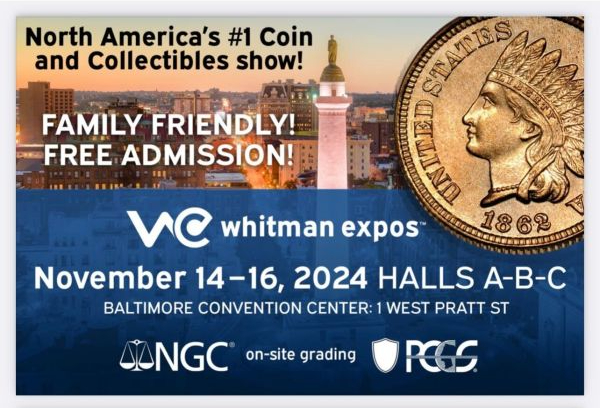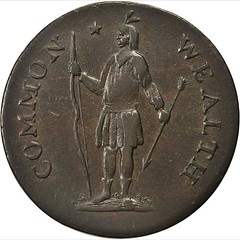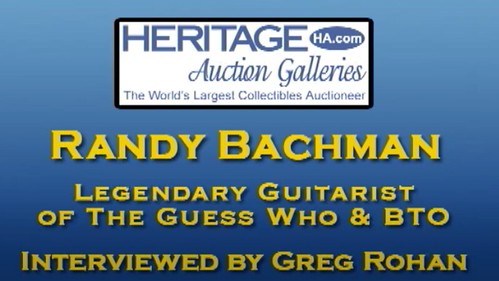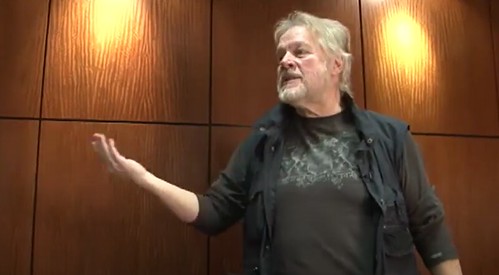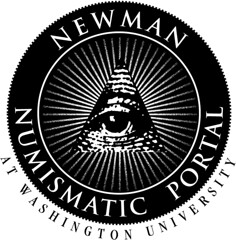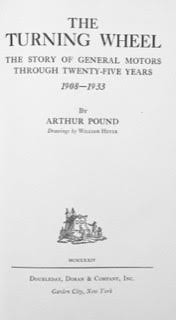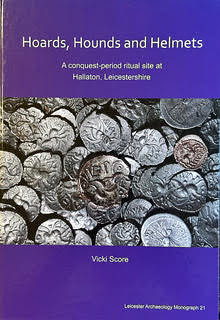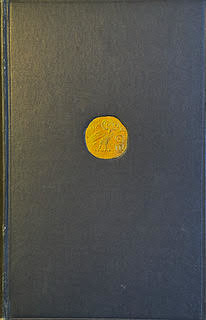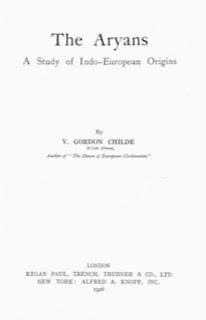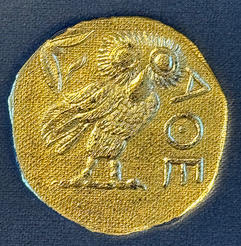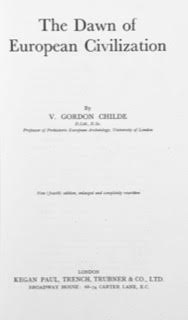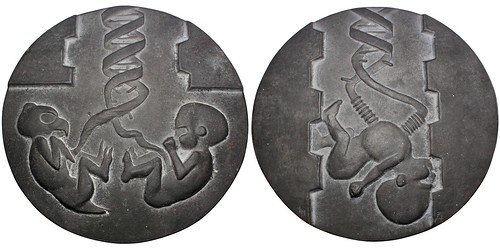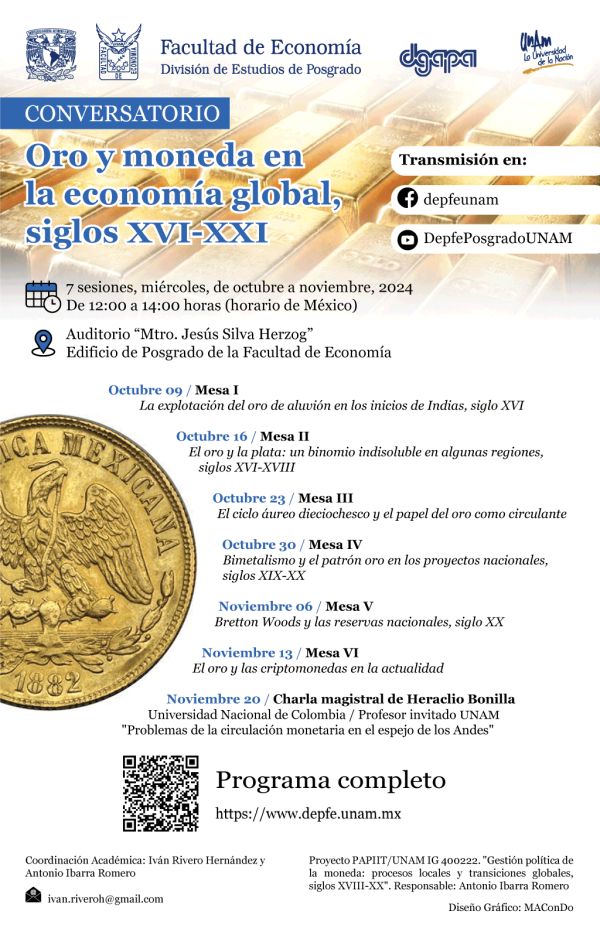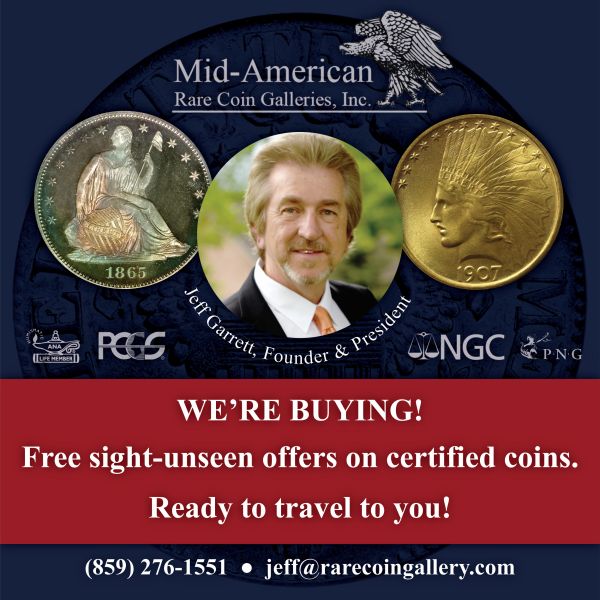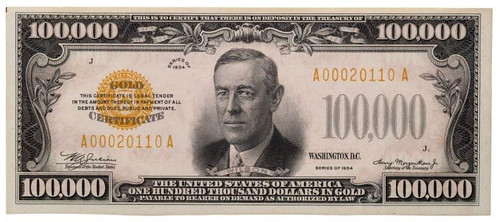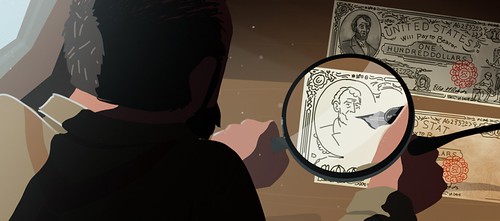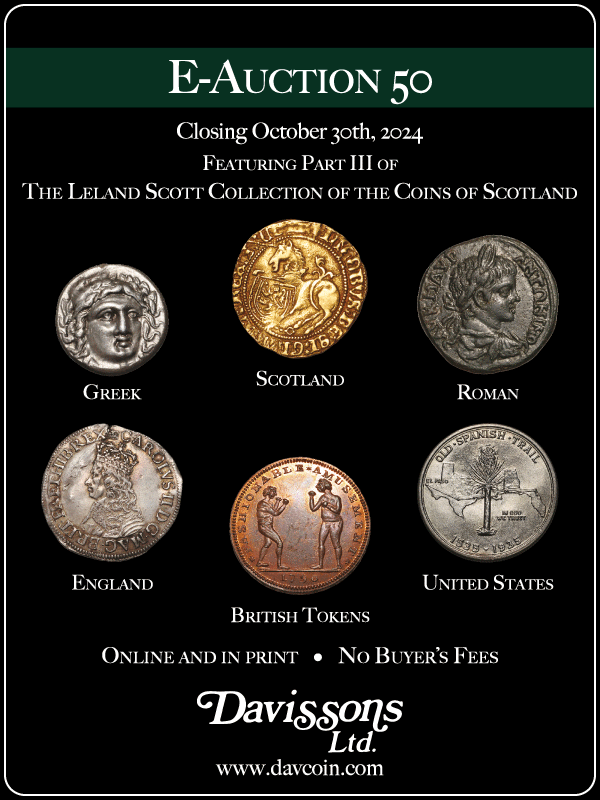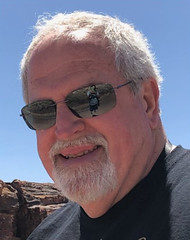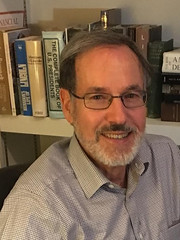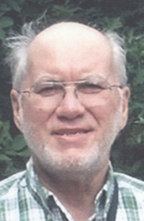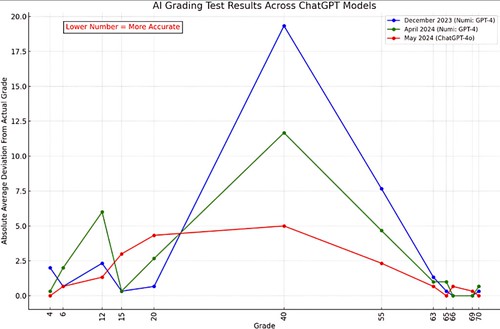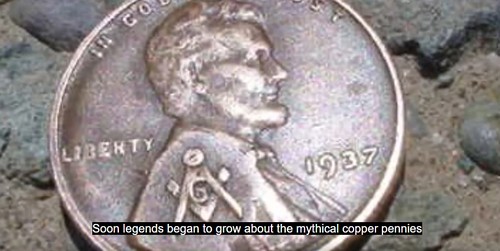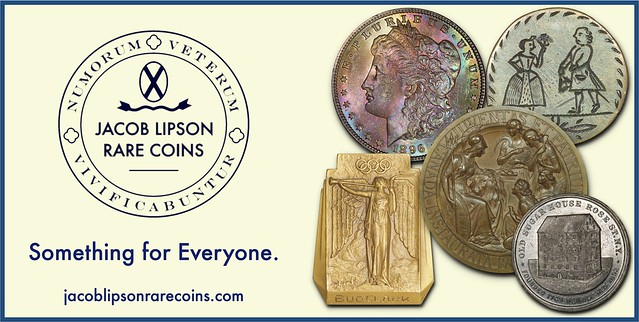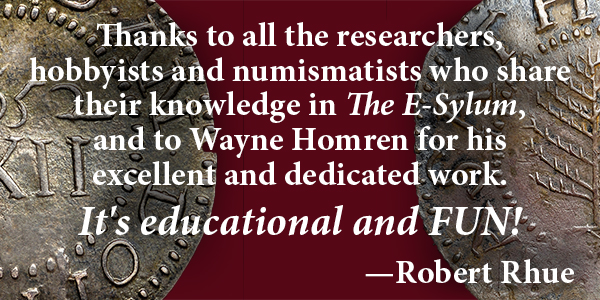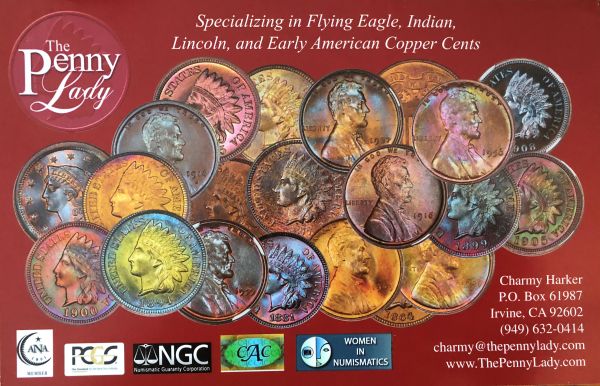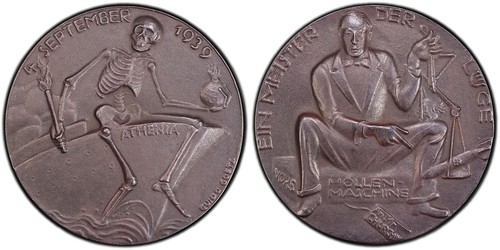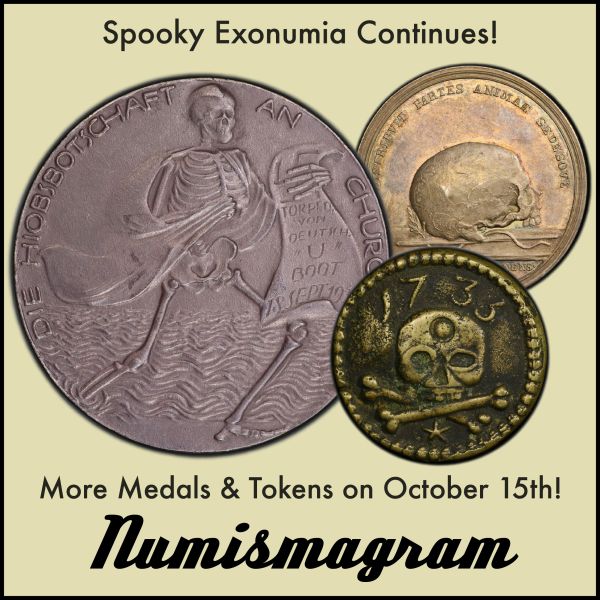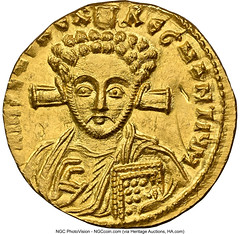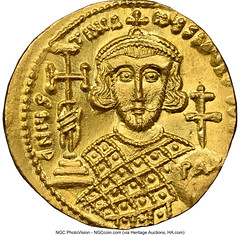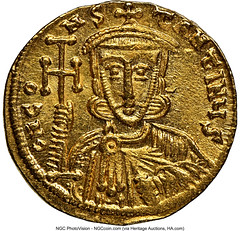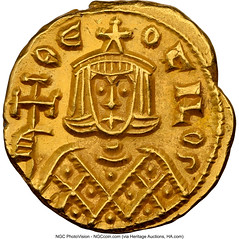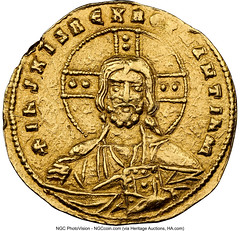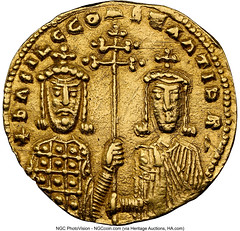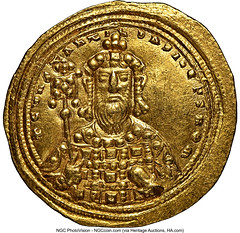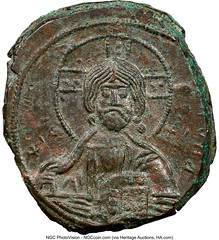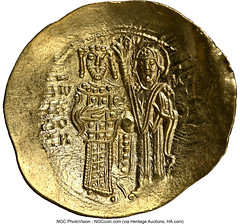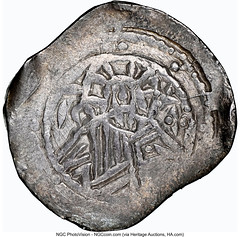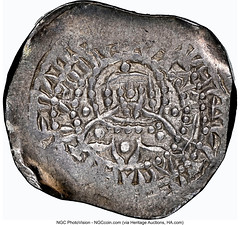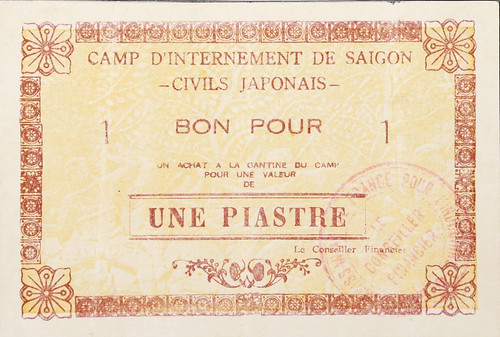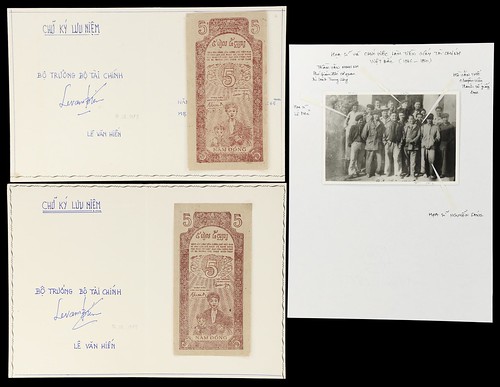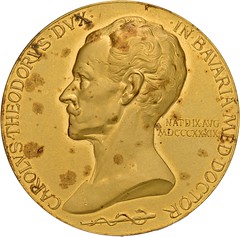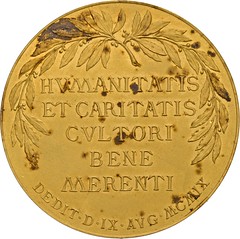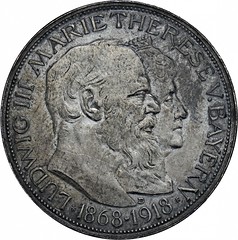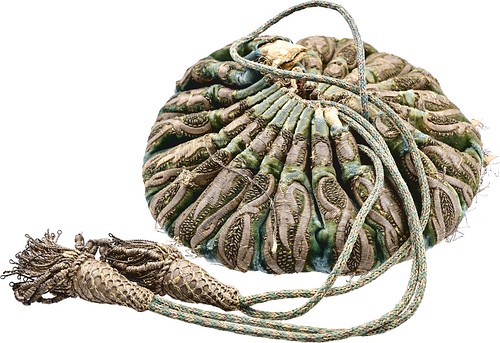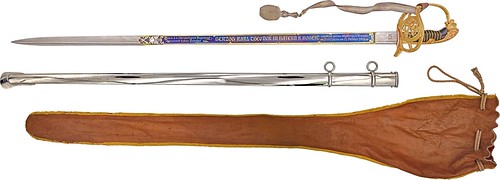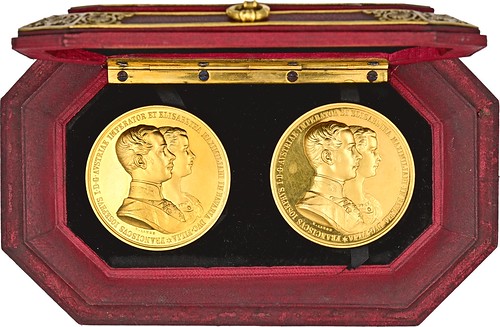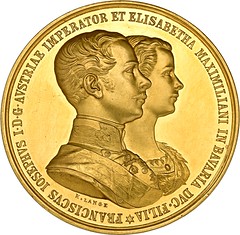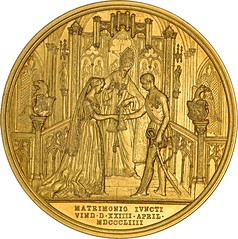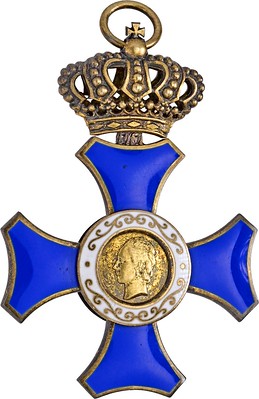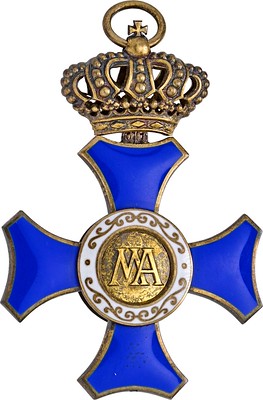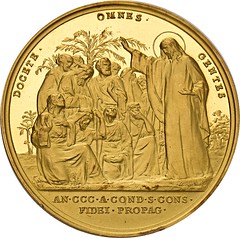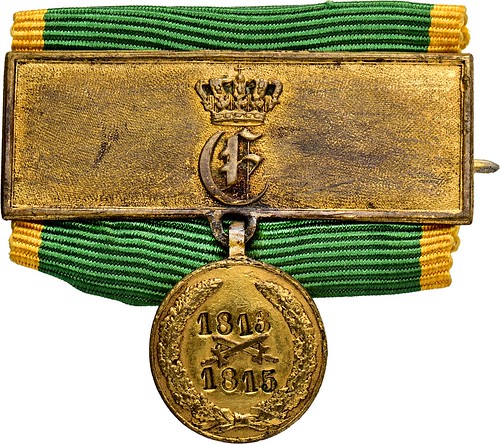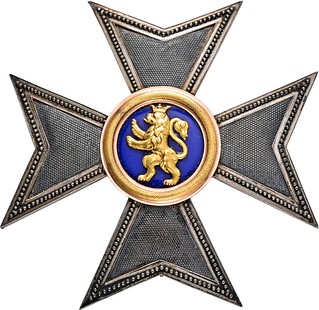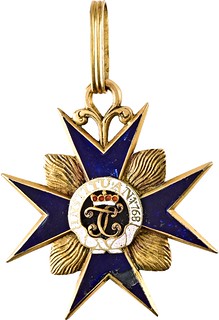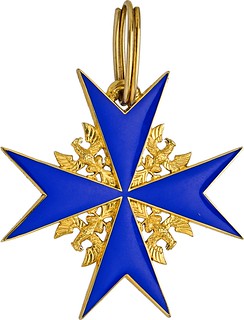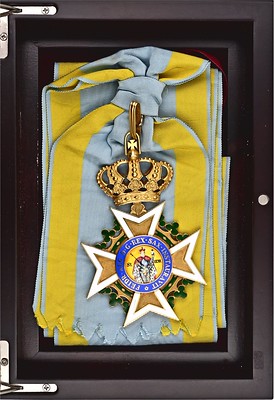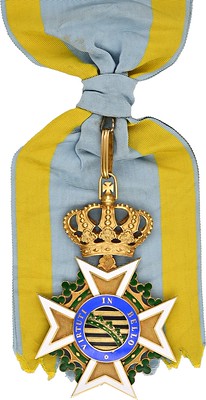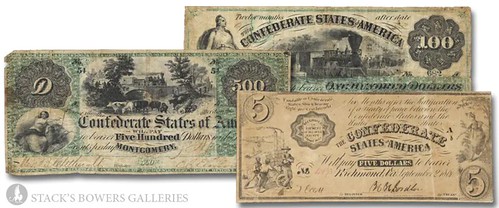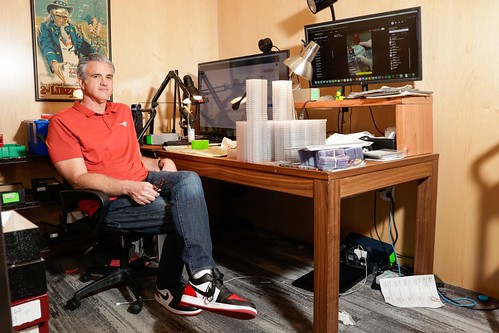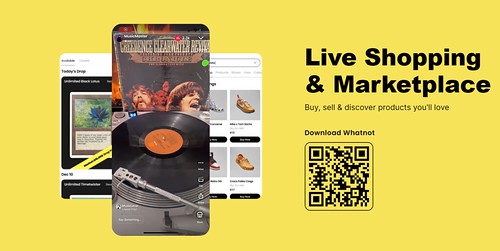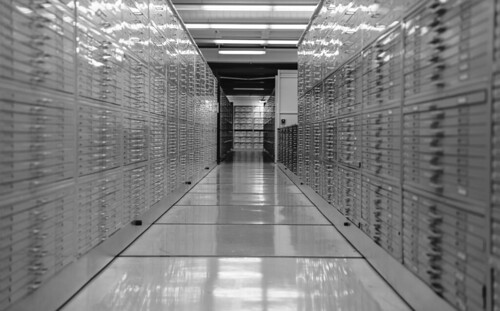
Visit our NBS Sponsors
About UsThe Numismatic Bibliomania Society is a non-profit association devoted to the study and enjoyment of numismatic literature. For more information please see our web site at coinbooks.org SubscriptionsThose wishing to become new E-Sylum subscribers (or wishing to Unsubscribe) can go to the following web page link MembershipThere is a membership application available on the web site Membership Application To join, print the application and return it with your check to the address printed on the application. Print/Digital membership is $40 to addresses in the U.S., and $60 elsewhere. A digital-only membership is available for $25. For those without web access, write to: Jeff Dickerson, Treasurer AsylumFor Asylum mailing address changes and other membership questions, contact Jeff at this email address: treasurer@coinbooks.org SubmissionsTo submit items for publication in The E-Sylum, write to the Editor at this address: whomren@gmail.com BUY THE BOOK BEFORE THE COINSale Calendar
|
- WAYNE'S WORDS: THE E-SYLUM OCTOBER 13, 2024
- NBS PODCAST FEATURES AI-POWERED GUEST HOSTS
- LANG NUMISMATIC LITERATURE AUCTION 4 SELECTIONS
- K&F BCD LIBRARY SALE, PART 2 HIGHLIGHTS
- WORKMAN'S BOOKS SALE 7 ANNOUNCED
- NEW BOOK: MARYLAND TAMS JOURNAL SPECIAL ISSUE
- NEW BOOK: DUTCH EAST INDIES PLANTATION TOKENS
- NEW BOOK: NETHERLANDS TRADING SOCIETY, 3RD ED.
- NEW BOOK: BILLETES ARGENTINOS 1884 – 2024
- ORIENTAL NUMISMATIC SOCIETY AUTUMN 2024
- ANS MILLER & RYDER CORRESPONDENCE DIGITIZED
- VIDEO: RANDY BACHMAN SELLS HIS COLLECTION
- THE INTERNET ARCHIVE AND THE NNP
- WAITANGI CROWN MINTAGE FIGURES
- MORE COINS ON BOOK COVERS
- NOTES FROM E-SYLUM READERS: OCTOBER 13, 2024
- NATIONAL NUMISMATIC COLLECTION UPDATES
- WOMEN WHO MODELED FOR AMERICAN SCULPTURE
- 2024 MICHIGAN STATE EDUCATIONAL EVENTS
- GOOGLE'S NOTEBOOKLM CREATES PODCASTS
- THE GOOD AND BAD OF AI IN NUMISMATICS
- VOCABULARY TERM: PRODUCT MEDAL
- HERBERT JACK KWART
- KELLEN HOARD INTERVIEW, PART ONE
- NUMISMAGRAM MEDAL SELECTIONS: OCTOBER 13, 2024
- HERITAGE AUCTIONS: BYZANTINE COINAGE
- HOWARD A. DANIEL III REFERENCE COLLECTION
- KUENKER AUCTION 415
- CONFEDERATE BANKNOTE RARITIES
- WHATNOT? WHY NOT?
- DIGITIZING THE NATIONAL ARCHIVES
Content presented in The E-Sylum is not necessarily researched or independently fact-checked, and views expressed do not necessarily represent those of the Numismatic Bibliomania Society.
WAYNE'S WORDS: THE E-SYLUM OCTOBER 13, 2024
 Thank you for reading The E-Sylum. If you enjoy it, please send me the email addresses of friends you think may enjoy it as well and I'll send them a subscription. Contact me at whomren@gmail.com anytime regarding your subscription, or questions, comments or suggestions about our content.
Thank you for reading The E-Sylum. If you enjoy it, please send me the email addresses of friends you think may enjoy it as well and I'll send them a subscription. Contact me at whomren@gmail.com anytime regarding your subscription, or questions, comments or suggestions about our content.
This week we open with an unusual new NBS BiblioTalk podcast, three numismatic literature auctions, our new books, a periodical, updates from the Newman Numismatic Portal, and more.
Other topics this week include Maryland tokens, Argentine paper money, a rock and roll celebrity collector, happenings at the National Numismatic Collection, artificial intelligence in numismatics, Henry Miller, Hillyer Ryder, Herbert Kwart, Kellen Hoard, Howard Daniel, Homo Superior, fixed price and auction previews, Confederate banknotes, Whatnot, and the National Archives.
To learn more about the BCD Library, plantation tokens of the Dutch East Indies, the mint of Tilimsan al Jadida, the Waitangi Crown, counterfeiter Jim the Penman, women who modeled for American sculpture (and coins), Presidential Election Campaign Medals, toned coins, dangerous AI mass-produced crapola, the Human Brain medal, and Byzantine coinage, read on. Have a great week, everyone!
Wayne Homren
Editor, The E-Sylum
NBS PODCAST FEATURES AI-POWERED GUEST HOSTS
The latest episode of the Numismatic Bibliomania Society podcast is now available for listening. It's on the NBS web site but also available elsewhere. President Len Augsburger provided this report. -Editor
NBS Podcast Features AI-Powered Guest Hosts
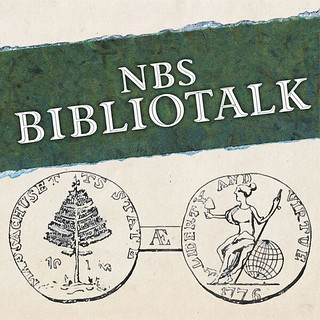 The latest episode of the NBS Bibliotalk podcast, "Literature Collecting and the Impact of Technology" is now available on the NBS website and other popular podcasting platforms such as Apple Podcasts. This episode is AI-generated and was created using the Google NotebookLM podcast engine. Text copies of Asylum issues were ingested as a basis for the podcast.
The latest episode of the NBS Bibliotalk podcast, "Literature Collecting and the Impact of Technology" is now available on the NBS website and other popular podcasting platforms such as Apple Podcasts. This episode is AI-generated and was created using the Google NotebookLM podcast engine. Text copies of Asylum issues were ingested as a basis for the podcast.
The virtual hosts provide an overview of the numismatic literature collecting field and discuss the impact of technology on the hobby. From the days of Sylvester Crosby and the Chapman brothers, the podcast conveys the appeal of numismatic literature and encourages listeners to find and collect their own special items.
While the production value is high, and the hosts seem eerily human, I found the content to be a bit lacking in substance. Still, the ability of AI to progress this far is astounding, and one can only expect it will continue to improve rapidly. Let us know what you think!
See the article elsewhere in this issue with more background and discussion on this development. -Editor
Link to "Literature Collecting and the Impact of Technology" on the NBS website:
https://www.coinbooks.org/resources/podcast.html
LANG NUMISMATIC LITERATURE AUCTION 4 SELECTIONS
Here are some selections from the numismatic literature auction from Numismatic Antiquarian Bookshop Lang, which closes October 15, 2024. -Editor
Dear collectors and friends of numismatic literature, We would like to remind you of the upcoming online auction of the Numismatic Antiquarian Bookstore Lang ! This auction offers you the opportunity to purchase valuable books and documents on coins, medals and numismatic history - from the comfort of your own home.
Date: Tuesday, October 15, 2024
Start: 16:00 CET
Location: Online at Auex.de
Auction Highlights:
- Rare numismatic works from different centuries
- specialist literature on numismatics and medal studies
- Copies from the DF Grotjohann and Reinhold Jordan libraries
A selection of particularly interesting books:
Lot 286
Tentzel, WE Saxonia Numismatica or Medalle-Cabint Commemorative coins and show pennies. 2 volumes. Contemporary full vellum, minimally foxed.
Estimated price: 1500.00 Euro
Lot 404
MacDonald, G. Catalog of Greek Coins in the Hunterian Collection. University of Glasgow. Glasgow 1899-1905. LXVI, 495 pp., 30 fn.; VI, 649 p., tfn. 31 - 62; VI, 799 p., tfn. 63 - 102. 3 volumes. Full cloth.
Estimated price: 1000.00 Euro
Lot 809
Schmidt, B. / Knab, C. Reussian Coinage History. Dresden 1907. IV, 283 p., 17 tfn. Half cloth, small water stain on the first pages.
Estimated price: 300.00 Euro
Lot 584
Evrard de Fayolle, A.-E. Research on Bertrand Andrieu de Bordeaux. Paris/Chalon sur Saone 1902. 237 p., 5 tfn. Half leather.
Estimated price: 200.00 Euro
The auction catalog is already available online! You can place your bids in advance or bid live on the auction date.
How to take part:
- register on the auction platform Auex.de.
- browse through the auction catalog, discover valuable works and place a pre-bid.
- bid online - from the comfort of your own home or on the move!
Don't miss the opportunity to enrich your numismatic library with rare and important works!
We look forward to your participation and wish you every success at the auction!
K&F BCD LIBRARY SALE, PART 2 HIGHLIGHTS
Here are additional highlights from the upcoming second sale of the BCD Library of ancient numismatics. -Editor
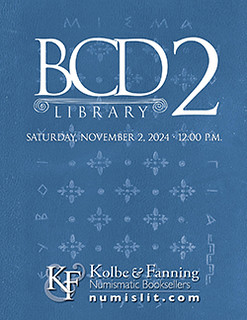 On Saturday, November 2, Kolbe & Fanning Numismatic Booksellers will be holding the second sale of material from the BCD Library, the most extraordinary private collection of material on the coinage of antiquity that we have ever handled. Featuring classic references, modern die studies of individual cities, descriptive catalogues of important collections, and much else, the BCD Library has something to offer anyone with an interest in the ancient world. The online catalogue can be accessed at
bid.numislit.com.
On Saturday, November 2, Kolbe & Fanning Numismatic Booksellers will be holding the second sale of material from the BCD Library, the most extraordinary private collection of material on the coinage of antiquity that we have ever handled. Featuring classic references, modern die studies of individual cities, descriptive catalogues of important collections, and much else, the BCD Library has something to offer anyone with an interest in the ancient world. The online catalogue can be accessed at
bid.numislit.com.
Some highlights of this first sale include:
Lot 41: Spyridis's history of the Olympic Games, featuring a rare printing of the program for the 1896 Olympics...
Lot 69: a 1691 expanded edition of Charles Patin's excellent Introduction a la connoissance des medailles, arguably his most influential work
Lot 74: the first illustrated edition (1671) of Spanheim's Dissertationes de praestantia et usu numismatum antiquorum...
Lot 120: a substantial set of the Revue belge de numismatique, being 95 volumes of this important journal, many of them in BCD bindings
Lot 153: Froelich's very rare 1758 Notitia elementaris numismatum antiquorum illorum, probably the final work published during his lifetime
Lot 190: a remarkable volume compiling eleven acquisition reports published by the Berlin Cabinet between 1874 and 1900, peak years of their collecting
Lot 170: the first volume of Rasche's 1778 update to Jobert, Die Kenntniss antiker Münzen, including all of the plates issued for the work
Lot 217: a rare, possibly unique, photographic record of the collection of Roman coins formed by Canadian collector Leo Meloche
Lot 240: Carl von Schachmann's 1774 Catalogue raisonné d'une collection de médailles, which was later donated to the Herzoglichen Sammlungen zu Gotha.
Lot 224: a fascinating 1842 manuscript by Samuel Weare Gardiner, based on the work of Erasmo Pistolesi, on the ancient coins at the Museo Borbonico
Register early to bid online
Bids may be placed via post, email, phone, as well as online. Kolbe & Fanning use Auction Mobility as our third-party online bidding platform. Auction Mobility is an app-based platform allowing users the ability to participate in the sale through phones, tablets and computers. To register for the sale, bidders must go to
bid.numislit.com and sign up. Once you have set up an account, you may browse lots, place advance bids, or participate in the live sale online. Those wishing to participate on their devices can download the Kolbe & Fanning app through the Apple or Google Play Store. The sale has also been listed on Biddr, NumisBids, and Numis24.
The printed catalogue has been mailed to all active customers on our mailing list. As international mail speeds have been inconsistent, we encourage our foreign clients to consult the electronic catalogue in case their printed catalogue does not arrive promptly. A PDF of the printed catalogue has been posted to our main website at numislit.com for those who prefer that format. Bids placed via post, email, or phone must be received by November 1, the day before the sale, in order for them to be processed. Advance absentee bids may also be placed at any time online at bid.numislit.com. Internet bidding will be available during the sale itself through the same platform.
Kolbe & Fanning Numismatic Booksellers LLC is a licensed and bonded auction firm in the State of Ohio, and our auctions are conducted by licensed auctioneers. For more information, please see the Kolbe & Fanning website at numislit.com or email David Fanning at df@numislit.com. To register for the sale, go to bid.numislit.com. We look forward to your participation.
To read the earlier E-Sylum article, see:
KOLBE & FANNING BCD LIBRARY SALE, PART 2
(https://www.coinbooks.org/v27/esylum_v27n40a02.html)
WORKMAN'S BOOKS SALE 7 ANNOUNCED
Alan Workman has a numismatic literature sale closing January 4, 2025. Here's the announcement. -Editor
The David Baker Numismatic and Treasure Library and other Consignments
Closing January 4, 2025
Workman's Books' seventh bid sale of rare and out-of-print books is currently being cataloged! The sale will close on Saturday, January 4, 2025. The sale features selections from the David Baker (1966 - 2023) library that includes many lots of rare and hard-to-find items on Latin American numismatics, U.S. and world numismatics, history, militaria, shipwrecks, sunken treasure, lost treasure, treasure hunting, lost mines, and treasure in the American West.
This bid sale is being held through the online venue iCollector, and all registrations, approvals, and bids will be handled there. For this bid sale the lots will be closing on a timed interval with extensions for any bids placed within 5 seconds of closing. If you already have an iCollector account, you still must "GET APPROVED" to bid for each sale by entering and confirming your information for this bid sale, like reviewing your shipping information and choosing your preferred way of payment.
Even though the sale is months away, now is the perfect time to get approved and register, as any registration issues can certainly be accommodated more easily in advance. Registration is always FREE (no extra fees or percentages for bidding online). Once you are registered and approved, you will receive notices by email closer to the date of the sale once the lots are uploaded and ready for bidding. The anticipated date the lots will go live is December 1, 2024
To visit the firm's website:
https://workmansbooks.square.site/
NEW BOOK: MARYLAND TAMS JOURNAL SPECIAL ISSUE
Editor Jane Sears has compiled a special issue of the Maryland Token and Medal Society Journal containing almost 250 articles and over 400 illustrations published over its 45-year history, telling the history of tokens and medals that were issued from merchants and individuals in the state of Maryland. What a great resource! The softbound volume is available on Amazon. -Editor
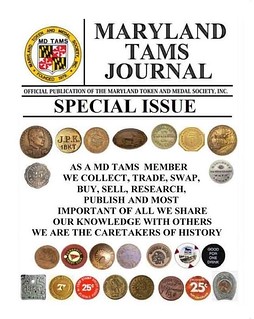 MARYLAND TAMS JOURNAL - SPECIAL ISSUE
MARYLAND TAMS JOURNAL - SPECIAL ISSUE
Language ? : ? English
Paperback ? : ? 200 pages
ISBN-13 ? : ? 979-8339695776
Item Weight ? : ? 1.3 pounds
Dimensions ? : ? 8.5 x 0.46 x 11 inches
$12.99
Maryland Token and Medal Society dues are due on January 1, 2025 for the 2025 membership year. Four journals are sent out to the membership per year. Email journals are in full color and snail mail journals are black and white paper. Send $10.00 to MD TAMS 2917 Churchville Road, Churchville, MD 21028
For more information, or to order, see:
MD TAMS JOURNAL - SPECIAL ISSUE: ARTICLES
(https://www.amazon.com/MD-TAMS-JOURNAL-SPECIAL-ARTICLES/dp/B0DHVW3CDW/ref=sr_1_1)
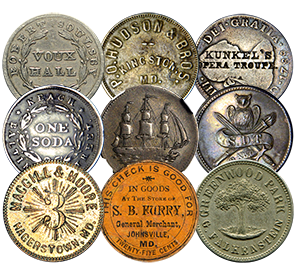 The Maryland Token and Medal Society is a scholarly organization and club devoted to the numismatic study of tokens, medals, and related objects from all cultures past and present originating from Maryland.
The Maryland Token and Medal Society is a scholarly organization and club devoted to the numismatic study of tokens, medals, and related objects from all cultures past and present originating from Maryland.
The Society was founded by token and medal collectors in 1979 interested in forming an organization focused solely on the study of Maryland exonumia.
Under the leadership of dynamic, resourceful, and generous officers, MD TAMS has grown to become Maryland's preeminent organization.
It supports research and education for the benefit of serious and novice collectors, numismatists, and hobbyists.
The Society meets regularly and participates in regional numismatic events. Four times each year, it publishes its quarterly MD TAMS Journal.
For more information on the Maryland Token and Medal Society, see:
https://www.mdtams.org/
NEW BOOK: DUTCH EAST INDIES PLANTATION TOKENS
The 6th edition of Adrian Lansen's book on plantation tokens of the Dutch East Indies has been published. -Editor
This new 6th edition lists 378 tokens with description, including one new Estate: Besilam – S & W, 16 new discovered tokens, 22 tokens provided with new data and 28 new token images. A detailed description is also given of the estates and companies that issued these tokens.
Each token is identified by its denomination, shape, size, weight, metal composition and die axis position. Insofar as possible, a colour illustration has been provided. The catalogue is in English and has an introduction in English and Dutch.
Hard Bound copy – 150 pages – Format A4
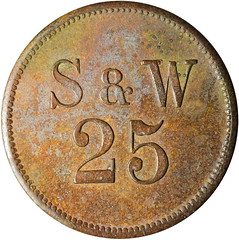 PRICE : 35,00 Euro, postage excluded.
PRICE : 35,00 Euro, postage excluded.
ORDER BY @ : lansenkil@hotmail.nl
or by post:
A.J. Lansen - Haanderik 94 - 3401 ET IJsselstein The Netherlands
PAYMENT : by bank account or PayPal
To read the earlier E-Sylum article, see:
NEW BOOK: DUTCH EAST INDIES PLANTATION TOKENS
(https://www.coinbooks.org/v25/esylum_v25n07a04.html)
NEW BOOK: NETHERLANDS TRADING SOCIETY, 3RD ED.
A new edition of the book on the Monetary Documents of the Netherlands Trading Society has been published, -Editor
New Book update: 3rd edition August 2024 :
Geldswaardige Documenten van de Nederlandsche Handel-Maatschappij
Monetary Documents of the Netherlands Trading Society 1888 – 1946.
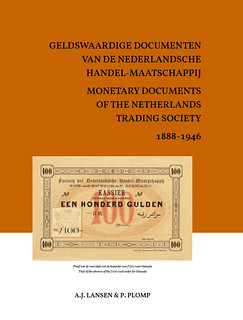 This book and catalogue on the Monetary Documents of the Netherlands Trading
Society describes, unique, for the first time, the intriguing history of the Cash orders
of the 1800 and 1900 series of Medan, Menado and Gorontalo in the Dutch East
Indies. Also the history of the Shanghai banknotes is covered in detail, from the very
first negotiations to have them printed to explaining the designs with historical
images and accompanying information, circulation and specimen banknotes of 5 and
10 dollars, dated 1st January 1909. A full description of the 50 and 100 Dollars
specimen notes, dated 1st January 1922, has also been added.
This book and catalogue on the Monetary Documents of the Netherlands Trading
Society describes, unique, for the first time, the intriguing history of the Cash orders
of the 1800 and 1900 series of Medan, Menado and Gorontalo in the Dutch East
Indies. Also the history of the Shanghai banknotes is covered in detail, from the very
first negotiations to have them printed to explaining the designs with historical
images and accompanying information, circulation and specimen banknotes of 5 and
10 dollars, dated 1st January 1909. A full description of the 50 and 100 Dollars
specimen notes, dated 1st January 1922, has also been added.
This 3rd edition contains interesting new information and additions to the previous editions.
Size: A4.
Pages: 141.
Images completely in colour.
Price: 35,00 Euro, excluding postage costs.
Payment by bank account or PayPal.
Order by email:
lansenkil@hotmail.nl
Mailing address: A.J. Lansen Haanderik 94 3401 ET
IJsselstein The Netherlands.
To read the earlier E-Sylum article, see:
NEW BOOK: NETHERLANDS TRADING SOCIETY
(https://www.coinbooks.org/v26/esylum_v26n45a06.html)
NEW BOOK: BILLETES ARGENTINOS 1884 – 2024
A new book has been published in Spanish on Argentine paper money. Here's a Google-translated excerpt from the German site Geldscheine Online. -Editor
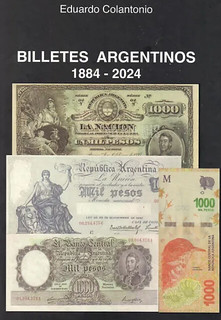 Eduardo Colantonio:
Eduardo Colantonio:
Billetes Argentinos 1884 – 2024
2nd edition Buenos Aires 2024.
249 pages, format 18 x 25.5 cm, hardcover, full color with numerous illustrations.
In Spanish.
ISBN 978-631-00-4255-8
Costs approx. EUR 45, to order from the author : educolantonio@gmail.com
International shipping is possible.
Eduardo Colantonio has been considered a proven expert on Argentine paper money for many years. His catalogue on Argentine paper money, first published in 2016, which has quickly become a standard work for this collecting area, has now been republished in a second updated and expanded edition.
The field of collecting Argentine banknotes has a lot to offer both the collector with a small budget and the expert. Since 1970, the country has sunk no fewer than five currencies into the maelstrom of inflation - the Peso Ley, Peso Argentino, Australes, Peso Convertibles and the Peso. What remains is a large number of banknotes, which can usually be purchased in shops for a few euros in mint condition. Today it is hard to believe that Argentina was once one of the wealthiest nations in the world due to its agricultural exports. The banknotes of the issuing banks with a state guarantee date from this period, as do the notes issued from 1895 by the Conversion Fund (Caja de Conversión), many of which are now sought-after rarities.
Colantonio's catalogue begins with the state's small change issues of 1884, then deals with the various issues of the issuing banks and the issues of the Conversion Fund, before moving on to the notes issued by the National Bank from 1935 onwards. The author uses a system of his own, consecutive catalogue numbers. The catalogue ends with the 10,000 pesos banknote from the "National Heroes" series, printed in China and issued from May 7, 2024, which shows the portraits of Maria Remedios del Valle and Manuel Belgrano on the front, and soldiers on horseback swearing allegiance to the Argentine flag in 1812 on the back - heroic motifs are widespread on Argentine banknotes. The individual sections are preceded by short introductions in which the basic data of the issue are presented, as well as watermarks and signatures. This makes it easier to compare and assign variants in your own collection.
All banknotes are shown in color with the front and back shown at about 50% of their original size and are generally graded in two grades - for banknotes issued from 1970 onwards in XF and UNC, for the older notes in VF and XF or Fine and VF...
The catalogue contains a lot of information that is missing from the SCWPM catalogue or the banknotebook and that is useful for interested collectors, such as watermark or signature variants for individual issues, or the list of control number ranges, which can be assigned to each year of printing and which allow conclusions to be drawn about the issue numbers, which are often quite low, especially for older notes with higher denominations...
To read the complete article, see:
Neuer Katalog: Billetes Argentinos (Argentinisches Papiergeld)
(https://www.geldscheine-online.com/post/neuer-katalog-billetes-argentinos-argentinisches-papiergeld)
ORIENTAL NUMISMATIC SOCIETY AUTUMN 2024
The Autumn 2024 issue of the Journal of the Oriental Numismatic Society has been published. -Editor
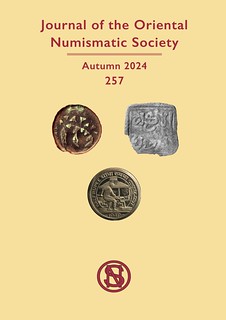 Journal of the Oriental Numismatic Society
Journal of the Oriental Numismatic Society
Autumn 2024
CONTENTS
Editorial
Paula Turner
A unique Yaudheya copper coin
Devendra Handa
Decoding symbols on Sasanian bronze and lead coins from Shapur II to Yazdgard II (309–457 CE)
O. Kucera
XRF analysis and Georgian–Sasanian coinage: A new dataset
Jonathan Ouellet
The mint of Tilimsan al Jadida and a new coin for the Marinids
Ludovic Liétard
Civic copper coins of Shushtar
B. Millancourt
1862 dotted rupee paradox
Amit Surana and Yatin Sawant
1949: The year of experimental pattern coins of India
Dilip Rajgor
A token with everlasting use
S. K. Bose
ONS News
Book reviews and notices
For more information, see:
https://www.orientalnumismaticsociety.org/
ANS MILLER & RYDER CORRESPONDENCE DIGITIZED
The latest addition to the Newman Numismatic Portal is correspondence of Henry C. Miller & Hillyer Ryder from the Howland Wood papers at the ANS. Project Coordinator Len Augsburger provided the following report. -Editor
Henry C. Miller & Hillyer Ryder Correspondence Scanned at American Numismatic Society
Scanning of the Howland Wood papers at the American Numismatic Society continues apace, with 2,225 individual [A-R] correspondent files scanned to date. This work began in November 2023 and promises to be complete in early 2025. Wood served as ANS Curator from 1913 to 1938 and clearly dedicated substantial time to handling his daily correspondence. Hillyer Ryder is best known for his contribution in 1919 to the American Journal of Numismatics (first series, vol. 53, part I of III), which covered die varieties of Vermont and Massachusetts colonial coppers. In the same edition, Henry C. Miller published on the Connecticut copper varieties. The die variety analyses paired well with Crosby's Early Coins of America (1875), which filled in the historical and legislative background of these issues.
The Miller / Ryder work was reprinted, in 1920, by the ANS under the title The State Coinages of New England. The Wood / Ryder correspondence provides detail surrounding the production of the American Journal of Numismatics, vol. 53, as well as the reprint volume, which in practice appears to have all occurred at the same time. Despite the 1919 publication date of AJN vol. 53, production clearly ran into 1920, per Wood's letter to Ryder of February 24, 1920. Production costs including "composition, paper, and printing" were split between ANS and the writers.
This cost (about $800 total to the writers) may have been the rationale for the lesser quality plates in this volume. While parts II and III of vol. 53 were produced with collotype plates, part I presented only halftones, as noted by Charles Davis in American Numismatic Literature. The correspondence indicates authors highly engaged with the ANS as the publisher, and although not explicitly discussed in the correspondence, the question of the plates surely must have been negotiated between the authors and ANS.
Image: 1787 Massachusetts Cent, Ryder 2a-F, the Crosby and Ryder plate coin, PCGS EF45. Ex. Twin Leaf (Stack's Bowers, March 2019), lot 8016, realized $90,000.
NOTE: At publication time, the Internet Archive site was offline, so the following links may not work until service is restored. -Editor
Link to Wood / Ryder correspondence:
https://archive.org/details/ryderhillyer191900amer
Link to Wood / Miller correspondence:
https://archive.org/details/millerhenryc191900amer
Link to Howland Wood ANS correspondence files:
https://archive.org/details/americannumismaticsociety?tab=collection&query=%22Howland+Wood%22
Link to American Journal of Numismatics (first series, vol. 53, part I):
https://nnp.wustl.edu/library/book/562547
VIDEO: RANDY BACHMAN SELLS HIS COLLECTION
The David Lisot Video Library on the Newman Numismatic Portal can be found at:
https://nnp.wustl.edu/library/multimediadetail/522852
We highlight one of his videos each week in The E-Sylum. Here's one from 2009 with celebrity collector Bachman Turner Overdrive guitarist Randy Bachman speaking about his collection. -Editor
I came up empty with a quick search on the Heritage archives. Could anyone point us to some specific lots from the Randy Bachman consignment? What did he collect? The video is worth a watch, but doesn't get into the specifics of his collection. -Editor
To watch the complete video, see:
Randy Bachman Sells His Collection with Heritage
(https://www.youtube.com/watch?v=toDCfl0nIXc)
THE INTERNET ARCHIVE AND THE NNP
"I just finished reading the October 6th edition of The E-Sylum. I felt disturbed by the piece on "Internet Archive Legal Battles."
"If the Internet Archive goes out of existence, will the NNP still be able to digitize and store numismatic literature and other materials?"
Here's the email exchange between Jeff, myself, and Newman Numismatic Portal Project Coordinator Len Augsburger. -Editor
I responded:
"Len can reply in more detail, but yes, digitization can proceed, although there would likely be disruption while other arrangements are made. And the existing digitized content is backed up by the University, so none of that would be lost - again, there just might be a delay while other hosting arrangements are made.
"IA is relied on by so many organizations I think some collective action would happen to prevent a shutdown or at least set up a new entity for transition, much like for-profit companies can rise again after bankruptcy.
"Thanks for your concern."
Len added:
"Yes, we've been following the Internet Archive litigation ever since it began – it's definitely a point of concern.
"Besides Internet Archive, there are other solutions in the market for digital repositories, so we are not dead in the water.
"We do have a copy of all NNP assets, which is stored on AWS (Amazon Web Services), separate from Internet Archive. Worst case, we move to another repository, which would be disruptive but not fatal."
Jeff wraps up:
"Wow, this is great news! Thankfully, other digital repositories are available if needed.
"Good to know that all NNP assets are stored on AWS. Thanks for keeping on top of all of these developments."
Thanks, everyone. Great discussion. To underscore the threat of losing the Internet Archive, their site has been down for several days following a hack attack. -Editor
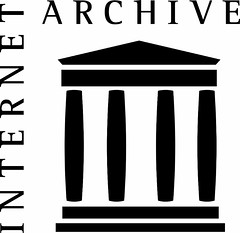 The Internet Archive will come back within "days" following a cyberattack that brought down the organization's vast digital library and the Wayback Machine, according to an update from founder Brewster Kahle.
The Internet Archive will come back within "days" following a cyberattack that brought down the organization's vast digital library and the Wayback Machine, according to an update from founder Brewster Kahle.
Currently, if you try to access the Internet Archive's website, you'll see a notice that says it's "temporarily" offline. Links to the Wayback Machine also won't load.
"The data is safe. Services are offline as we examine and strengthen them. Sorry, but needed. @internetarchive staff is working hard. Estimated Timeline: days, not weeks," writes Kahle.
To read the complete article, see:
The Internet Archive is still down but will return in ‘days, not weeks'
(https://www.theverge.com/2024/10/11/24268040/internet-archive-data-breach-outage-hacked)
I also had a conversation with Len this week, and we both agree that the Internet Archive is "too big to fail" - so important to so many individuals and institutions that the world will find a way to keep it going one way or another. Stay tuned for any further developments. -Editor
To read the earlier E-Sylum article, see:
INTERNET ARCHIVE LEGAL BATTLES
(https://www.coinbooks.org/v27/esylum_v27n40a27.html)
WAITANGI CROWN MINTAGE FIGURES
Last week we excerpted an article on the Waitangi Crown by Andrew Crellin, and asked if anyone could help Andrew refine the mintage numbers. Martin Purdy of Upper Hutt, New Zealand answered the call. -Editor
By way of background, for a long time the established understanding was that there were 364 proofs and 764 uncirculated coins, but this was rectified in 1992 by research by Dr Michael Humble published in the NZ Numismatic Journal of that year (NZNJ #70, p. 13ff), which established that, in addition to the 364 coins issued in proof sets, the total mintage also included 104 loose proof coins, which reduced the total for the uncirculated coins to 660.
The table in the article on the Sterling Currency website contains an error in the totals along the bottom, since the "totals" shown for proof and uncirculated coins mix mintages for both (take a second look at what's being added up in each case and it should become clear!). The totals in the right-hand column are correct, however.
The coin was not intended to commemorate the 95th anniversary of the Treaty - that would be a strange number to pick, and the centenary was duly marked with a circulating halfcrown commemorative in 1940. According to NZ Numismatic Society records (March 19, 1936), it was originally hoped to have the crown issued in 1934 to mark the first celebration of "Waitangi Day" but its issue was delayed by a year. The Treaty House and grounds at Waitangi had been gifted to the nation by the Governor-General, Lord Bledisloe, in 1932, and "Waitangi Day" was first celebrated in 1934, making this a fitting theme for New Zealand's first crown piece. The change of date was unfortunate, although the issue in 1935 then coincided with jubilee issues in the UK and Canada for the King's own 25th anniversary.
Another curiosity for those who like playing with numbers is that the total mintage of the uncirculated and proof Waitangi crowns matches the combined total of the octagonal and round 1915 gold US$50 commemoratives (660+468 vs. 645+483, or 1128 in each instance).
Martin provided corrections to Andrew's mintage table and numbers from Dr Humble's 1992 article. I passed everything along to Andrew. -Editor
Andrew writes:
"That is great feedback, thank you for passing it on.
"I don't mind looking like a dolt if it means the correct information comes out.
"I'll ensure Martin's table is included in the article, it is certainly better than the one I prepared.
"Thanks again for facilitating this!"
Thanks, everyone - glad to help. -Editor
To read the earlier E-Sylum article, see:
NEW ZEALAND'S 1935 WAITANGI CROWN
(https://www.coinbooks.org/v27/esylum_v27n40a24.html)
MORE COINS ON BOOK COVERS
Last week David Vagi kicked off a discussion of non-numismatic books with images of coins on their covers. Bob Van Arsdell supplied these. Thanks! -Editor
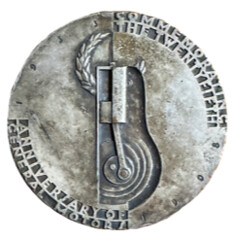 1) Pound, Arthur, 1934, The Turning Wheel, with "25th Anniversary of General Motors" medal by Norman Bel Geddes, Medallic Art Company silver-stamped on cover (actual medal placed on book cover for comparison and reverse of the medal imaged separately).
1) Pound, Arthur, 1934, The Turning Wheel, with "25th Anniversary of General Motors" medal by Norman Bel Geddes, Medallic Art Company silver-stamped on cover (actual medal placed on book cover for comparison and reverse of the medal imaged separately).
2) Score, Vicki, 2011, Hoards, Hounds and Helmets, Excavation Report for Hallaton, Leicestershire, UK. (shows Hallaton Hoard of Celtic Corieltauvian coins found during excavations).
3) Childe, V. Gordon, 1926, The Aryans – a study of Indo-European Origins. (with gold-stamped image of Athenian Owl coin reverse). The publisher would use this same gold stamp on Childe's books for over 20 years.
4) Childe, V. Gordon, 1947, The Dawn of Civilization, 4th edition (enlargement of the same gold-stamped coin image; it appears the gold-stamping die may have been touched-up at some point or perhaps replaced entirely because the images are not identical).
To read the earlier E-Sylum article, see:
NOTES FROM E-SYLUM READERS: OCTOBER 6, 2024 : Coins on Book Covers
(https://www.coinbooks.org/v27/esylum_v27n40a10.html)
NOTES FROM E-SYLUM READERS: OCTOBER 13, 2024
Homo Superior and David Bowie
Ken Spindler of San Diego writes:
"Homo Superior" is the name of that strange medal that you posted last week.
"David Bowie referred to "Homo Superior" in the song, Oh, You Pretty Things!, possibly referring to members of a perfected race of humans. In fact, he says it twice, including at the very end."
Thanks. I remember the medal, but hadn't internalized its name. Now I'll remember. Interesting connection/coincidence. I don't recall seeing the term before, but I'll probably see it everywhere now. Wiktionary tells me the term was coined in 1935. -Editor
For more information, see:
Oh! You Pretty Things
(https://genius.com/David-bowie-oh-you-pretty-things-lyrics)
Homo superior
(https://en.wiktionary.org/wiki/Homo_superior)
To read the earlier E-Sylum article, see:
NUMISMAGRAM MEDAL SELECTIONS: OCTOBER 6, 2024
(https://www.coinbooks.org/v27/esylum_v27n40a16.html)
Gold and Currency in the Global Economy, 16th-21st centuries
Pablo Luna Herrera writes:
"Regarding Mexican gold coinage, an important event will be held in Mexico City. It will be both online and in person at the renowned Economy Faculty of the UNAM (Universidad Nacional Autonoma de México), the most prominent university in Mexico.
"The lecture series will take place all Wednesdays of October and November at 12 p.m. and will cover the evolution of gold currency, considering Mexico has the oldest mint in the continent.
"Further details and the option to view the content online can be found on the Facebook page: https://www.facebook.com/depfeunam."
Thank you. Here's the poster for the event, in Spanish. -Editor
NATIONAL NUMISMATIC COLLECTION UPDATES
National Numismatic Collection Curator Ellen Feingold passed along these updates for E-Sylum readers. Thank you - these are great to hear. -Editor
We have some updates from the NNC that we want to share with your readers.
First, we are updating The Value of Money gallery as it approaches its 10th birthday next year. For this purpose, we have closed the gallery to the public and it will reopen around November 15, 2024. For a description of the updates and new content, please see here.
Also, the NNC was recently featured in the Smithsonian's podcast Sidedoor in an episode on Jim the Penman. You can find that here.
Finally, over the past two years we have been working in partnership with the National Museum of Ukraine in the Second World War (also known as the War Museum) to create a web exhibition using coins, banknotes, and stamps to highlight Ukraine's cultural heritage and the impact of the Russian invasion on it. You can see that here.
All great news! Here are excerpts from the linked pages. -Editor
EXHIBITION OPENINGS
Value of Money
Updated Exhibition Experience
Gallery of Numismatics, One West
Opens Nov. 15 - Ongoing
"The Value of Money" exhibition features a number of updates to mark its 10-year anniversary and will include a changing display case, a refreshed entry feature and extensive new content. The exhibition connects American history to global histories of exchange, innovation, political change, and cultural interaction and expression through more than 300 objects from the museum's National Numismatic Collection. Behind the massive vault door entrance, the new entryway includes diverse objects spanning more than 4,000 years from ancient cuneiform tablets to modern money. Across the gallery, visitors will see some of the collection's most recently acquired objects, including an IRS agent's laptop that helped the U.S. government seize $3.6 billion of stolen cryptocurrency in 2022 – resulting in the largest financial seizure in U.S. history. Another recent addition, Chinese coins from the Howard F. Bowker Collection will explore the history of money in China. A special display, "Revolutionary Money," features the wide range of objects in circulation in early America, such as a beaver pelt, colonial and European coins, and Continental banknotes. Popular objects, among the rarest in the world, will continue to delight visitors, including the legendary "1933 Double Eagle," the first U.S. $20 gold coin from 1849, a $100,000 bill printed in 1934, and the famous 1804 silver dollars known as "the king of coins."
To read the complete article, see:
Calendar of Exhibitions and Events: November 2024 and Native American Heritage Month
(https://americanhistory.si.edu/press/releases/November-2024-calendar)
During the mid-1800s, one third of all paper money in America was thought to be fake. It was the golden age of counterfeiting, and one exceptionally talented con artist stood out from all the rest. His fakes were nearly perfect…but for a trademark tell. Known to law enforcement only as "Jim the Penman," this celebrity criminal led many Americans to wonder—can great art truly be criminal?
To read the complete article, see:
Jim the Penman
(https://www.si.edu/sidedoor/jim-penman)
Coins, banknotes, and stamps are made to circulate. As they travel, they carry evidence of the places they were made and the people who made them. Ukrainian coins, banknotes, and stamps feature national symbols and diverse cultural heritage sites spanning more than a thousand years.
As Russian leaders seek to erase Ukrainian national and cultural identity by actively targeting heritage sites, these small circulating objects have the outsized role of preserving this heritage in pockets, mailboxes, and collections around the globe.
The artifacts in this exhibition represent a unique cross-section of Ukraine's enduring statehood and heritage. Brought together from museum collections in Ukraine and the United States, they showcase Ukrainian history, diversity, and resilience.
To read the complete article, see:
Preservation Through Circulation: Ukraine's Enduring Statehood and Heritage
(https://global.si.edu/success-stories/preservation-through-circulation-en)
WOMEN WHO MODELED FOR AMERICAN SCULPTURE
Justin Perrault passed along information about a Michener Art Museum (Doylestown, PA) lecture and exhibit of interest to collectors of coins and medals designed by Augustus Saint-Gaudens and Daniel Chester French. Thank you. -Editor
Get to know Audrey Munson and Hettie Anderson, two of Augustus Saint-Gaudens and Daniel Chester French's favorite models. These women carved a living for themselves out of an emerging and competitive field at a time when women were only just beginning to find work outside the home. Although the final sculptures largely depict allegorical figures and goddesses, its these all too real women whose faces decorate American civic spaces. Join us as Rebecca McCarron, Michener Registrar, brings the models' names and identities to the forefront.
This is a two-part program that requires separate registration for each event.
Virtual Program via Zoom
Wednesday, October 23 / 7 p.m.
Pay what you wish (free/$10/$20)
The first program will be virtual held online via Zoom on October 23 at 7pm. The link to access the event will be sent to the email address used during the pay-what-you-wish registration. You will receive the link on the morning of October 23. Please double-check your spam/junk folder if you do not receive the confirmation email. If you encounter any difficulties in registering or accessing the Zoom link after registering, please email jmchugh@michenerartmuseum.org. The event will be recorded and shared if you are unable to attend live.
Gallery Talk at Michener Art Museum
Wednesday, December 4 / 1 p.m.
$10 Member/$20 Non-Member/$5 Student
The second program will be a gallery talk. On December 4, Rebecca will lead the group through the exhibit, Monuments and Myths: The America of Sculptors Augustus Saint-Gaudens and Daniel Chester French. Gallery Talks provide the guest with the opportunity to hear from different voices at the museum and view the pieces from a new perspective. The smaller group provides a more personal way to learn about our exhibitions and collection.
For more information, or to register, see:
Nameless No More: Meet the Real-Life Women Who Modeled for American Sculpture
(https://www.michenerartmuseum.org/event/virtual-nameless-no-more-meet-the-real-life-women-who-modeled-for-american-sculpture/)
Here's some information about the accompanying exhibit. -Editor
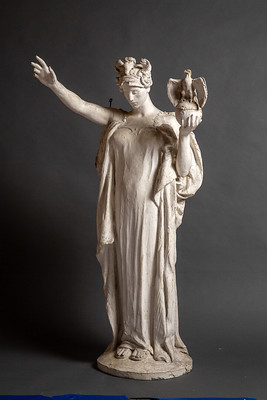 Augustus Saint-Gaudens (1848–1907) and Daniel Chester French (1850–1931) were the preeminent American sculptors of the late nineteenth and early twentieth centuries. As friendly rivals, they transformed sculpture in the United States, producing some of the country's most recognizable public artworks, including French's Seated Abraham Lincoln in the Lincoln Memorial in Washington, D.C. and Saint-Gaudens's Diana, which graced the top of Madison Square Garden in New York. With an aesthetic of remarkable formal elegance, Gaudens and French created a picture of national ambition rooted in conceptions of liberty, grandeur, and common cause. These narratives of an ascendant America, however, reflect only a partial vision of the nation. Rife with the potential for multiple meanings and contested histories, the artworks in this exhibition encourage us to question the stories that public art tells and to explore what—and whose—histories remain hidden from view.
Augustus Saint-Gaudens (1848–1907) and Daniel Chester French (1850–1931) were the preeminent American sculptors of the late nineteenth and early twentieth centuries. As friendly rivals, they transformed sculpture in the United States, producing some of the country's most recognizable public artworks, including French's Seated Abraham Lincoln in the Lincoln Memorial in Washington, D.C. and Saint-Gaudens's Diana, which graced the top of Madison Square Garden in New York. With an aesthetic of remarkable formal elegance, Gaudens and French created a picture of national ambition rooted in conceptions of liberty, grandeur, and common cause. These narratives of an ascendant America, however, reflect only a partial vision of the nation. Rife with the potential for multiple meanings and contested histories, the artworks in this exhibition encourage us to question the stories that public art tells and to explore what—and whose—histories remain hidden from view.
Drawn primarily from the collections of the artists' historic homes and studios, Monuments and Myths is the first exhibition to bring together Saint-Gaudens and French in this way, probing their intersecting biographies and examining the affinities that made both of them leaders in their field. As we collectively refocus our attention on the role and meaning of historic monuments, it is a timely moment to ponder the continuing power of these artists' sculptures and to examine how it has shaped—and continues to inform—our understanding of America.
Monuments and Myths: The America of Sculptors Augustus Saint-Gaudens and Daniel Chester French is co-organized by the American Federation of Arts, Chesterwood, a site of the National Trust for Historic Preservation, and the Saint-Gaudens Memorial in partnership with Saint-Gaudens National Historic Park.
For more information, see:
https://www.michenerartmuseum.org/mam_exhibitions/monuments-and-myths-the-america-of-sculptors-augustus-saint-gaudens-and-daniel-chester-french/
https://www.michenerartmuseum.org/
THE BOOK BAZARRE
2024 MICHIGAN STATE EDUCATIONAL EVENTS
A number of educational talks are planned for next month's Michigan State Numismatic Society show in Warren, Michigan. -Editor
All Sessions Are Held in the Macomb Room
1:00 P.M.
The Evolution of Bald Eagles on US Coins
By Tim Coleman
If you haven't heard Tim speak, here's your opportunity. Tim does great PowerPoint presentations on a variety of topics, and they are always interesting. Here is his topic description: See how the Bald Eagle changed from the early years of United States coin production to the modern-day strikes. See what years and which denominations of coins included an artist's Bald Eagle interpretation on either the obverse or reverse.
2:00 P.M.
A Collection of Presidential Election Campaign Medals- Andrew Jackson through Abraham Lincoln
By Ernie Nagy
These medals were issued to persuade voters during election cycles. Some promote policies which were debated during the day, some have fascinating stories. In total they document the era when Electoral College representatives were first selected by voters and not state legislatures. Some of the pieces in the collection resemble coins which circulated at the time, some are fine works of numismatic art. The collection includes pieces issued by the winning candidates now familiar to us, and also those who ran unsuccessfully and are all but forgotten. A few of the pieces are rare, but a surprising number of them are easily obtainable. Whether or not you collect these, if you enjoy American history you'll find this talk interesting.
3:00-4:00 p.m.
Robert Campbell from Utah presenting a special presentation on toned Coins
 Bob is an internationally known specialist on toned coins, coming to us from Utah! Also,
a summer seminar instructor for 30+ years at the nationally known Summer Seminar,
Bob will give you a mini-seminar in rainbow-toned coins. Here is the official description
of his talk.
Bob is an internationally known specialist on toned coins, coming to us from Utah! Also,
a summer seminar instructor for 30+ years at the nationally known Summer Seminar,
Bob will give you a mini-seminar in rainbow-toned coins. Here is the official description
of his talk.
Become familiar with the color sequence of rainbow toning on coins, the difference between natural and artificial toning, and the contrast between "liquid transfer directional gas" and "air transfer" toning.
Bob leads an exploration of artificial frosting and surface reproofing. H. Robert Campbell is an ANA past president and owner of All About Coins. Bob is known as the foremost authority on toning in the United States. In an hour and a half, you will learn more about toning on coins than 20 years of trying to figure it out yourself.
All meetings and speakers in Macomb Room
9:15 a.m. – Paper Money Collectors of Michigan Meeting
10:00 a.m. – Michigan Token and Medal Society Meeting
11:30 a.m.-1:00 p.m.
YN Luncheon and Auction
Join Mike Dennany and others in an interesting talk and auction for all Yns and their parents and others. Always a good time, you will learn something and get to bid on some great coins and other items of numismatics! Pizza is always provided!
1:15 p.m. – 2:15 p.m.
Collecting Medals by Bob Hatfield
Join former Mich-TAMS president Bob Hatfield as he explores the field of Collecting Medals! Bob will bring items to show us and have a presentation for all who love medals to enjoy!
For more information on the Michigan State Numismatic Society, see:
https://www.michigancoinclub.org/
GOOGLE'S NOTEBOOKLM CREATES PODCASTS
See the first article in this issue for a link to the newest NBS Bibliotalk podcast. In a first, it was generated by artificial intelligence. This came together quickly, and credit goes to NBS President Len Augsburger, who is also the Project Coordinator for the Newman Numismatic Portal. As an NNP consultant, I help gather new content and occasionally pass along ideas that may be relevant. After reading a Wall Street Journal article last week about the Google NotebookLM tool, I forwarded it to Len noting that it could be a way to generate accessible summaries of NNP content. Here's an excerpt from the article. -Editor
 Have you heard about the latest hit podcast? It's called Deep Dive—and you have to check it out.
Have you heard about the latest hit podcast? It's called Deep Dive—and you have to check it out.
Each show is a chatty, 10-minute conversation about, well, any topic you could possibly imagine. The hosts are just geniuses. It's like they know everything about everything. Their voices are soothing. Their banter is charming. They sound like the kind of people you want to hang out with.
But you can't. As it turns out, these podcast hosts aren't real people. Their voices are entirely AI-generated—and so is everything they say.
And I can't stop listening to them.
This experimental audio feature released last month by Google is not just some toy or another tantalizing piece of technology with approximately zero practical value.
It's one of the most compelling and completely flabbergasting demonstrations of AI's potential yet.
This one is definitely cool, but it's also useful and easy to use. All you need to do is drag a file, drop a link or dump text into a free tool called NotebookLM, which can take any chunk of information and make it an entertaining, accessible conversation.
Google calls it an "audio overview." You would just call it a podcast.
One of the coolest, most useful parts is that it makes podcasts out of stuff that nobody would ever confuse for scintillating podcast material.
Wikipedia pages. YouTube clips. Random PDFs. Your college thesis. Your notes from that business meeting last month. Your grandmother's lasagna recipe. Your resume. Your credit-card bill! This week, I listened to an entire podcast about my 401(k).
And then I found myself listening to an oddly captivating Deep Dive into that day's edition of the Federal Register.
Each conversation is between the same male and female voices—Google says they don't have names—and it takes only a few minutes to create one. If you didn't know anything about it, you wouldn't guess it was automatically generated. It doesn't sound like other AI slop. It just sounds like any other podcast. And once you start playing with it, you'll probably become obsessed with it.
The first time I heard a Deep Dive, it reminded me of an AI version of Acquired, the hit podcast about business history. When I told the hosts, they tried it out for themselves, opening NotebookLM and uploading a Google Doc with links to some of their sources for a recent show on Microsoft. Not their notes—just a bunch of links. They found the results to be mind-blowing.
"I don't know whether to be amazed or terrified," Acquired co-host David Rosenthal said.
Exactly. There have only been two times when I had my mind blown by AI. The first was my introduction to ChatGPT. This was the second.
To read the complete article, see:
There's a New Hit Podcast That Will Blow Your Mind
(https://www.wsj.com/tech/ai/google-notebooklm-ai-podcast-deep-dive-audio-c30a06b3)
On the NBS Facebook page, Marcus Davis writes:
"I just listened to the most recent episode of the podcast. It's terrifying how quickly AI is growing."
Also on Facebook, NBS Treasurer Jeff Dickerson writes:
"I'm in agreement. There are a few factual errors that the discerning ear can pick out, but the novice ear would take at face value. The podcast reminded me of a book report by a high schooler (perhaps myself at a time) presenting a tale built from a skimming of the text. Not quite right, but not easily dismissed."
Here are NBS Historian Joel Orosz's thoughts. -Editor
This is a worthwhile experiment, illuminating at once how far AI has come, and how far it has to go.
On my first listen-through, I was amazed at how plausible the two voices sounded, and how much better AI is getting at simulating the give-and-take of human conversations. A casual listener, listening through once, probably would not suspect that this was AI-generated.
But the second listen-through revealed cracks in the polished facade. The identities of the two narrators subtly shifted between neutral interviewers to knowledgeable enthusiastic hobbyists and back again. There are at least half a dozen points at which one of the narrators responds in subtly inappropriate ways to the other (such as mismatched tones of voice). The patter between the narrators gets steadily more redundant as their "conversation" goes on until, near the end, a large chunk of the "dialogue" is repeated, almost verbatim.
If the order given was: "create a promotional piece for numismatic literature in the context of an informal dialogue between a lay male interviewer and a knowledgeable female numismatic literature collector" then Google Notebook LM did a reasonably good job (notwithstanding the hiccups mentioned above) of executing on that order. It delivered mostly plausible dialogue, lots of promotional sloganeering, and a number of solid examples (Crosby, Chapman), to support it. Notebook also pitched it right, threading the needle between abecedarianism and esoterica.
But if the order included, "and get the history right," the execution left much to be desired. John J. Ford did not invent numismatic bibliomania in a road to Damascus moment after a Garrett sale. Coin Cards are not the center of the numismatic bibliophilia universe. The dive into The Asylum somehow missed nearly everyone of prominence in the hobby, from Attinelli to Zander, and folks like Katen and Kolbe in between. In fact, outside of Early Coins of America, and plated Chapman catalogs, hardly a book or a catalog is mentioned.
So, a worthwhile experiment, but I hope that AI-generated content will be placed back on the shelf for the near future. It simply lacks the insights, wit, and creativity of human writers. Until it gains them, I see no need for the NBS to employ it.
Thanks, Joel. I would agree that this was a worthwhile experiment, although I wouldn't stop experimenting. The entirety of The Asylum is a lot of ground to cover, and human curation could help. An "audio overview" of a set of Asylum and E-Sylum articles mentioning say, John J. Ford or the Chapman Brothers could well be more aligned with the actual facts. Regardless, disclaimered less-than-perfectly factchecked summaries of obscure but interesting topics in numismatics could be just the lure to entice new collectors and researchers to the field. And who knows where the technology could be in two years, let alone twenty.
I was heartened this week to see well-deserved Nobel Prizes awarded to AI researchers Geoffrey Hinton and Demis Hassabis. -Editor
Both Hinton and Hassabis were born in London, albeit nearly three decades apart...
The foundations were shaped over centuries. The UK was a serious player in statistics, logic, mathematics and engineering – think Thomas Bayes, George Boole, Charles Babbage, Ada Lovelace – long before Alan Turing asked: "Can machines think?" As computers became an established technology, expertise flourished at a handful of centres.
First came the physics prize. The American John Hopfield and the British-Canadian Geoffrey Hinton won for foundational work on artificial neural networks, the computational architecture that underpins modern AI such as ChatGPT. Then came the chemistry prize, with half handed to Demis Hassabis and John Jumper at Google DeepMind. Their AlphaFold program solved a decades-long scientific challenge by predicting the structure of all life's proteins.
To read the complete article and more, see:
‘They don't just fall out of trees': Nobel awards highlight Britain's AI pedigree
(https://www.theguardian.com/science/2024/oct/11/nobel-awards-highlight-britains-ai-pedigree-demis-hassabis-geoffrey-hinton)
Has the Nobel Prize cancelled physics and chemistry?
(https://unherd.com/newsroom/has-the-nobel-prize-cancelled-physics-and-chemistry/)
THE GOOD AND BAD OF AI IN NUMISMATICS
It's early days, and while many of us have had fun experimenting with the latest incarnations of artificial intelligence, it's too soon to stop experimenting and declare victory or failure. Here are a few recent examples, one encouraging and the others... not so much. -Editor
AI Coin Analysis and Grading
Justin Hinh submitted this update on his work with AI coin analysis. -Editor
My work on AI coin analysis and grading has me closely following advancements in AI models, and the industry is evolving rapidly.
Previously, AI could only analyze static images of coins, which severely limited accuracy.
Collectors know the importance of viewing coins from multiple angles and lighting. Well...Google's just updated Gemini 1.5 Pro to support video uploads. It can now analyze thousands of frames instead of just a few images. This is a game-changer. Below are AI grading results when I used just uploaded photos for analysis.
I recorded a short video to check whether it would even return coherent results. I ran a quick test on a slabbed 1925 Lincoln Cent. The AI accurately identified the coin, though the grade was slightly off. That's okay, though. If I had used a high-resolution camera, set up better lighting, conducted additional tests to determine the optimal video length, and fine-tuned the model, I bet I would have gotten an accurate grade.
That's not to mention that OpenAI just released the best AI model in the market, the o1 model, which now has PhD level intelligence and reasoning. That model can't take video inputs yet, but I'm excited to test it out when it does.
In short, AI is now just two steps away from surpassing human graders. The next step is AI being able to analyze a live video feed. The final step after is integrating live video into a robotics platform. The AI would be able to analyze a coin in real time. Just like a human, it can dynamically rotate a coin to see all angles. But beyond a human, it can:
- Adjust to any lighting conditions.
- Quickly snap from 2x to 20x lens to inspect specific spots.
- Switch to different viewing modes like LiDAR for 3D scanning.
- Use X-ray to determine composition and identify counterfeits.
- And so much more
At some point the narrative will shift from "AI can now mimic a human grader" to "AI is better than a human grader in every way".
I will note that my underlying assumption is AI using technical grading standards. Market grading is a whole other beast.
Let the experiments continue! -Editor
More AI-Generated "Books"
Now this is an experiment I could do without. The AI-generated "books" appearing on the market are cringeworthy - so bad that they're somewhat entertaining. But I try looking away from this trainwreck. The covers, text descriptions and robot-generated "reviews" look fine, and it's listed as "#1 Best Seller in Antique & Collectible Precious Metals." I briefly considered ordering one just for grins, but couldn't bring myself to support this crap. See the review below. -Editor
Discover valuable U.S. error coins hiding in plain sight with our comprehensive guide!
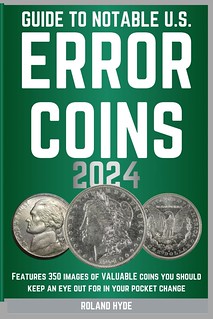 Packed with 350 clear images and detailed descriptions, this book will help you easily identify valuable error coins found in circulation, providing crucial insights into their current market values. Unlike rare coins that are hard to come by, this guide focuses on the coins you might find in your pocket, making it a valuable resource for both beginners and experienced collectors. Beyond being a reference guide, it offers tools, resources, and expert advice on handling, preserving, and profiting from your collection. Whether you're seeking a new hobby or aiming to earn extra income, this guide is your key to discovering the world of error coin collecting.
Packed with 350 clear images and detailed descriptions, this book will help you easily identify valuable error coins found in circulation, providing crucial insights into their current market values. Unlike rare coins that are hard to come by, this guide focuses on the coins you might find in your pocket, making it a valuable resource for both beginners and experienced collectors. Beyond being a reference guide, it offers tools, resources, and expert advice on handling, preserving, and profiting from your collection. Whether you're seeking a new hobby or aiming to earn extra income, this guide is your key to discovering the world of error coin collecting.
Features Inside This Book Include:
- Comprehensive list of valuable error coins with 350 clear images.
- Current market values for each error coin.
- Basics of coin collecting for newcomers.
- Educational Tools for Coin Collectors.
- Expert advice on handling, preserving, grading, and authenticating coins.
- Step-by-Step Guide to Roll Coin Hunting
- Notable valuable U.S. error coins, starting with Lincoln Cents, Jefferson Nickels, Washington Quarters, Roosevelt Dimes, and more.
- Tips for getting started with coin collecting, determining coin values, selling strategies, and avoiding fake coins.
- Coin glossary for easy reference and useful websites.
Grab your copy, get started with coin collecting today and uncover the hidden treasures in your pocket change!
Among the bland positive robo-reviews on Amazon are the occasional remarks of an actual human who made the mistake of ordering a copy. -Editor
"This book is not factual - It is not accurate and full of misinformation. No factual accuracy. Totally inaccurate. Inaccuracy on almost every page.
The claim of 350 photos is misleading. There are only 132 eBay listings as valuable error coins listed. I counted over 90 mistakes in this book. This book is written by taking parts of writings and all of the photos from the internet, some of which is not correct.
How can a book like this be a best seller? What are your credentials? If I could use my credentials to get this book removed, I would.
Do not use this book to determine what error coins are. Many of cut and pastes from eBay are incorrectly listed as errors. Of the many I have listed four below and stopped after the Nickels. Some of the photos are bad, so actually validating is impossible.
There is a photo and an error listing for a 2002-D Lincoln cent closed AM - This is not an error, but a standard business strike - 2nd closed is not correct wording, it is close AM
There is another 2002-D Lincoln cent listed as struck through grease - It is not anything, but a circulated coin and millions of coins appear like this.
2017-P Lincoln cent listed as struck through grease is incorrect.
2001-P Jefferson nickel missing cladding - What does this mean? This Jefferson nickel is made of a mixed alloy, there is no layering
2004-P Jefferson nickel listed as a retained cud - This is not a retained cud; it is a die crack.
He uses "double die" which is not correct - it is doubled die
Glossary - Some of the definitions are incorrect and others are misleading. Below is just a few.
Brass - Incorrectly states pennies are made from brass
Flan - Although a "flan" is a metal disk, this is not an American term for planchet.
Fair - A coin in pretty rough condition, not very valuable. There are some coins in fair condition that are very valuable. What defines "pretty rough condition"
The concepts of this book were taken from other books written by authentic numismatic writers. It is a partial copy reworded of all the areas in other books without any quotes.
These books that spread false information are not good for advancing the collecting community."
To read the complete book description and comments, see:
GUIDE TO NOTABLE U.S. ERROR COINS 2024: Over 350 images of VALUABLE coins you should keep an eye out for in your pocket change.
(https://www.amazon.com/GUIDE-NOTABLE-U-S-ERROR-COINS/dp/B0CSNPF85L/ref=pd_rhf_ee_s_pd_sbs_rvi_d_sccl_2_5/143-7912398-8058039)
AI-Generated Video
This video purports to tell the story of Don Lutz and his 1943 Philadelphia Lincoln Cent in bronze. The text is reasonable, but the images are a jumbled mix of some small bits of reality and mostly total crap. It must have been generated by AI. Tom Caldwell of Northeast Numismatics is named and pictured in it, sometimes accurately, sometimes not. Really weird to watch. This is mass-produced crapola. -Editor
Len Augsburger writes:
"This is kind of dangerous – because the production value is high, people assume the content is likewise. We're going to be seeing a lot more of this."
We're definitely in a new world. AI is a tool like all those that came before it - it can be used for good, for harm, or just a fast buck. -Editor
To watch the complete video, see:
Boy Notices Odd Mark On Old Coin, Finds Out It's Actually Worth $1M
(https://www.msn.com/en-us/video/watch/boy-notices-odd-mark-on-old-coin-finds-out-it%E2%80%99s-actually-worth-1m/vi-AA1rO7Rd)
VOCABULARY TERM: PRODUCT MEDAL
Here's another entry from Dick Johnson's Encyclopedia of Coin and Medal Terminology. -Editor
Product Medal. A medallic item made of a composition that is the business product of the issuing firm. It is surprising the number of enterprising firms that have used what they manufacture or sell to fashion into a medal. Most such product medals are fabricated by the manufacturers themselves and not by employing the services of a conventional medalmaker. Most product medals are distributed free to prospective customers of the issuing firm as a form of advertising.
Obvious metal firms dealing in bronze, brass, copper, silver and such could have medals in typical fashion made by medal manufacturers. But any composition that can be fabricated – struck, cast or molded into a permanent form – could be made by the companies themselves.
The Columbian Exposition at Chicago in 1892 may have been the impetus for the creation of this item. An early example – it may have been one of the first – is the hard rubber medal (with a mirror inside) made by the Hamburg Rubber Comb Company of Hamburg, Germany.
The Dutch Boy Paint Company made one of lead to characterize its lead-based paints (when such content was considered a benefit). Others have been made of leather, plastics, ceramics and such in addition to many metals.
To read the complete entry on the Newman Numismatic Portal, see:
Product Medal
(https://nnp.wustl.edu/library/dictionarydetail/516553)
HERBERT JACK KWART
E-Sylum Feature Writer and American Numismatic Biographies author Pete Smith continues his look at numismatic columnists with this article on writer Herbert Jack Kwart. Thank you! -Editor
Herbert Jack Kwart is a book author, coin columnist and investment counselor born in 1922. If he is still living, he can be added to our list of hundred-year-old numismatists.
Herbert was born on January 31, 1922, in Pittsburgh, the son of Louis (1891-1961) and Millie (1892-1974) Kwart.
He began collecting coins as an Eagle Scout. As an adult, he was a scout leader and district scout commissioner. He received scouting's Silver Beaver Award, the highest honor for an adult scout leader.
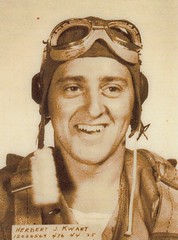 During World War II, he served as a staff sergeant in the U. S. Air Force Based in England. He
flew 35 combat missions with the 8 th Air Force, 534th bomber squadron.
During World War II, he served as a staff sergeant in the U. S. Air Force Based in England. He
flew 35 combat missions with the 8 th Air Force, 534th bomber squadron.
Kwart graduated from the University of Miami in 1950. Shortly after graduation he was married to Roslyn S. Kivel (1925-2005) on June 25, 1950, in Florida City, Florida.
In May of 1951, he was manager at Ayers Finance Co. in Mami When he was alone in the office over the lunch hour, he was tied up and robbed at gunpoint.
He was an engineer with Xerox after 1968. In 1977 he took a "social service leave" to promote scouting for handicapped youth.
Herbert Kwart joined the ANA in 1973 as member R-76273. Roslyn S. Kwart joined in 1974 as A-77609. Herbert was noted for recruiting new members but otherwise did little for the ANA.
Described as a coin expert and investment counselor, he spoke about coins at public meetings. He taught non-credit classes about coin collecting at Nova University in Fort Lauderdale in 1979, and Florida International University in Miami in 1980. He was sometimes called "professor" although that was probably not a legitimate academic title.
In the 1970's. he was owner of the World Wide Currency Exchange on Treasure Drive in Miami.
In 1978, he was secretary-treasurer for the World Paper Currency Collectors. The club was originally called the Maryland Foreign Paper Money Club in 1961 but changed the name in 1969.
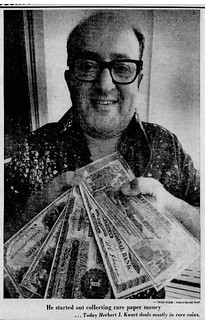 The Miami Herald had an article and photograph in their issue of January 20, 1980. He had some
interesting comments about coins and investments.
The Miami Herald had an article and photograph in their issue of January 20, 1980. He had some
interesting comments about coins and investments.
"I'm like a stockbroker. I do the same thing, except I do it in rare coins. All I've got to do is pick up the phone and call New York or California. In 24 hours, I've got what you want."
He recommended clients put from 15 to 20 percent of their investments into collectibles like stamps, antiques, jewelry or any other items of value.
"The next 10 years [will be] perfect, not just for coins, but in the whole field of collectibles."
Kwart contributed a "Coins" column on Tuesdays in The Miami News beginning with the issue of May 13, 1980. His emphasis was on coins as an investment. His last column was published on September 22, 1981, adding up to 66 articles over that period.
Kwart picked an unfortunate time to offer investment advice. He could report on strong gains in value seen over the previous years. Then the silver market collapsed in March of 1980 and the market went into a period of decline while his column was running.
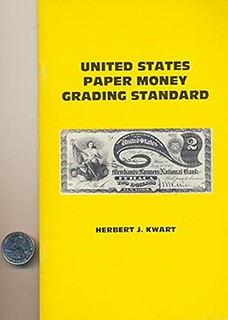 In 1984 his book was published on United States Paper Money Grading Standard. Joe Boling
wrote a review in 1984. Here is a brief excerpt.
In 1984 his book was published on United States Paper Money Grading Standard. Joe Boling
wrote a review in 1984. Here is a brief excerpt.
"Alas, I am sorely disappointed. This book is poorly written, unedited, contains errors of fact, and provides no insights for collectors of grades below XF. It seems to be aimed at investors, with the intent of justifying a price structure for uncirculated paper money similar to that used for US coins."
If the book had been well received, it might have made him famous. Instead, he appears to have faded from the hobby after publication.
Herbert died on August 14, 2021, and is buried at Golden Gate National Cemetery in San Bruno. California. Before I found his date of death, I found a listing for him on "True People Search." This listed him as age 102 and living in San Jose, California. It even had a phone number for him. My excitement at finding another 100-year-old numismatist was premature. He died about five months before his one-hundredth birthday.
KELLEN HOARD INTERVIEW, PART ONE
Greg Bennick's latest interview for the Newman Numismatic Portal is with Young Numismatist Kellen Hoard. Here's the first part, where Kellen talks about parental support for Young Numismatists and spreading the hobby by emphasizing the stories behind the coins. -Garrett
GREG BENNICK: Hi everybody, Greg Bennick here with the Newman Numismatic Portal. Thanks for joining yet another interview in the series that I'm doing with prominent numismatists and interesting people. And I'm here today with Kellen Hoard. Kellen and I are co-inhabitors of the Pacific Northwest, and we're both here in the Northwest corner of the United States today. We're going to have a fun conversation. So, Kellen, thanks for hanging out. I appreciate it.
 KELLEN HOARD: Good to see you, Greg. I think I'm only "a prominent numismatist" to my mother, but I appreciate you saying that.
KELLEN HOARD: Good to see you, Greg. I think I'm only "a prominent numismatist" to my mother, but I appreciate you saying that.
GREG BENNICK: You know, that never ends, right? As long as we have our moms with us, that's always true. I put out a book this last week. I had a book come out. And my biggest fan, I don't know how many copies she purchased, is indeed my mother. So that's exciting.
KELLEN HOARD: My mother has been very supportive of numismatics for me generally. I started when I was nine years old, and so I couldn't drive myself anywhere. I really couldn't do much of anything. And so, she, even as a non-numismatist, was supportive and driving me to coin club meetings. My first show, which was the ANA Portland show in 2015, which was great. And she was totally there for me 100%. The day I turned 16, she said, "Go get your driver's license. You're taking yourself to your coin shows now. I was here for you while you weren't able to, but you are more than welcome to go do things all by yourself now."
GREG BENNICK: Wow. I mean, I like that, though. I like that she was supportive. And I like that she kind of baby birded you out of the nest and said, "Go fly."
KELLEN HOARD: That's right. Well, actually, the very first time I ever drove a car by myself, she said, "Go get me some candy at the store." So, I did. I said, "Okay, mom, thanks for letting me get my driver's license." I think that was kind of the trade-off, is that I would go get her something from the store in exchange for me kind of having that freedom.
GREG BENNICK: That's great. And I'm assuming she still supports your collecting endeavors and or the work that you do.
KELLEN HOARD: As much as a mother does who knows nothing about what I do. Again, totally supportive, but she'll have colleagues or friends say, "What's Kellen doing in coins?" And she can vaguely say that I am continuing to do coins, but perhaps not much more than that. So, it's the perfect amount of support from somebody who doesn't really understand.
GREG BENNICK: I like that. That's actually an interesting question that I should be asking all interviewees. How do you integrate your coin life with your social life and other lives? Right? Because I'm fortunate enough to have a partner who has heard me talk about error coins enough that she's starting to know the difference between a clip planchet and a brockage. Right. But how do you do that? How do you how do you have conversations with other people in the world, who have no idea about the things you do?
KELLEN HOARD: You know, that's a question you shouldn't have asked because it's a long answer, but I'll try and keep it short. The long and the short of it is" a couple different ways. So, I have a girlfriend here in Seattle, and she has learned so much just through osmosis, just being near me to the point where there was at some point, we were driving the car together and it came up. I was asking her coin trivia questions, and she was very game for answering these questions. And she knew most of them, which was shocking. Like I never explicitly, I don't think, taught her anything, but she just kind of absorbed it.
Sometimes I'll get a cool new coin. She's excited to see that. I'm happy, I guess. But that's about it for there. But I am a columnist for The Numismatist, and I write it with three other young collectors. So, we replaced Dave Bower's column that he had run, but now we do a young collector's corner. And I'd written a column toward the beginning of college when I was in my freshman year. And I had been concerned because the kind of the classic story of numismatists is that they get interested in it when they're young, when they become teenagers, high school, college students, they kind of drop out their other interests, financial obligations, and so on. They come back to it kind of in their middle age when they kind of that rekindle the interest and they have a little bit more money. And then in their golden years, that's when they really get into it. They write and research and spend big money and really get back into the hobby.
And I was concerned since I started collecting, like, "Oh my God, I'm going to fall into this trap of losing interest." Fortunately, I never have. And I've had opportunities to keep engaging. But it was interesting as I continue my interest going into college, going to Washington, D.C. for college. And I continue to have interest in coins and talk to my peers about them. And college students are fascinated by coins, specifically the stories, the context, the history, the learning opportunities. I mean, they're in a learning environment already.
So, for them to be able to learn in kind of a new non-academia way, or at least the way I was presenting it to them, but more as history in your hands. They found it quite compelling. Which leads into kind of my broader philosophy is that with getting people engaged in the hobby, it's not that they're not interested. They just have no idea about the hobby. There's not some, especially younger people with myriad other opportunities for entertainment engagement. But they found it really quite compelling. And that was hopeful to me. And so, I give a lot of presentations to the public. I speak at a lot of retirement homes about numismatics or schools.
And what I find there is they don't care about grades. They don't care about pricing. That could not be less relevant or interesting to them. But they love the story. They love the context. So, I've been building up basically a reference set of coins and tokens and paper money and medals, transcending time and space, in which each piece has some kind of context around its creation that I know the public's like, "Ah, I didn't even think about that." And they find it really quite compelling. And then they have an opportunity to actually hold it in their hands as well, as they hear me talk about it.
So, in terms of social engagements with numismatics, to get back to your question is, yeah, socially, what I do is I share stories that I know are going to pique their interest. We never get into the granular details. They don't need to know about, you know, PCGS implementing plus grades. Nobody cares about that, even though I have some stake in that. But they're interested in socially how they can learn through the coins. They find that really quite compelling.
So that's how I've really incorporated into my social life to not be the total geek. You know, it's not to kind of bore them with it, but to find opportunity to connect with them over, those coins. One last piece I'll add on this: when I'm at a lot viewing at a Heritage or Stacks Bowers sale at a show. I'll go to lot viewing and I can never afford any of it, but I have a great time looking at it. I always get the most expensive item I can find in the sale and just look at it because why not? That's your opportunity to. But the people who staff the lot viewing... they are not collectors. They're usually temp employees from the local area.
And so, I again, I socialize with them through the coins. So many collectors just look at it themselves. I say, "Do you want to take a look at what I'm looking at?" and I tell them the story behind it. They love it. They're endlessly fascinated by this. They're sitting there all day thinking about it. So, you have an opportunity to then have an inlet with them and ask them, "Well, what are you interested in? What is anything you're interested in?" And this applies not just in lot viewing, but social lives generally. And they might say any number of things. I had a guy say he loves sailing. Phenomenal. Collect coins or tokens with boats on them. There's endless options at every budget level.
I had a woman say that she was really in touch with her religion. Even better. Countless people collect coins related to different religious things. I had a girl at college say, "I just love getting wasted on the weekends." I said, "Great. Smirnoff has a line of tokens that you can collect." You know, Smirnoff vodka. You put it on the bump and you spin it around on the bump and the arrow points to who pays for the round of drinks, right? No matter what your interest is, there is something for you. So that's how you build that social connection as well, is that it actually does tie to something. You're basically talking about their interests in a numismatic lens. And they find that...I find really quite exciting.
GREG BENNICK: I love that. John Kraljevich and I were talking the other night about how it's really all about the story. It's about the story behind the coin.
KELLEN HOARD: He captured that story so well.
GREG BENNICK: Yeah, for sure. I find that that's true. You know, you can talk to people about error coins. They're interested in how weird the coin looks, but the process behind it, maybe, but the thing that I collect that people find really fascinating, counterstamps, and the history of a merchant who counter stamped the coin and where they were from and why they stamped the coin. All of a sudden people are really interested in the story and the coin is a symbol of that. So, I love that you found that.
KELLEN HOARD: I have Brunk's book on counterstamps somewhere on that shelf right there. Yeah, that's a great book.
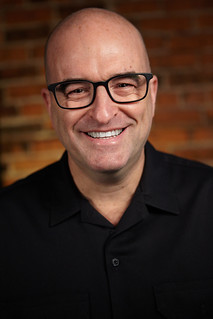 About the Interviewer
About the Interviewer
Greg Bennick (www.gregbennick.com) is a keynote speaker and long time coin collector with a focus on major mint error coins. Have ideas for other interviewees? Contact him anytime on the web or via instagram @minterrors.
To watch the complete video, see:
Kellen Hoard Interviewed for the NNP by Greg Bennick
(https://youtu.be/tBb-Bt4NR8k)
To read the complete transcript, see:
Kellen Hoard Interviewed for the NNP by Greg Bennick (Transcript)
(https://nnp.wustl.edu/library/book/641580)
NUMISMAGRAM MEDAL SELECTIONS: OCTOBER 13, 2024
Numismagram's Jeremy Bostwick sent along these three medals from his upload of new Halloween-themed medallic art to his site. For all of the new items, please visit https://www.numismagram.com/inventory, and be on the lookout for more being added this week! -Editor
102719 | BELGIUM. Luik (Liège). Chapter of St. Lambert's bronze Méreau or Communion Token. Dated 1686. Used for the receiving of food during feast day celebrations (20mm, 4.32 g, 6h). ANNIVERSARIVM, skull and crossbones // ECCLESI LEODI, crossbones between two flames. Edge: Plain. De Renesse pl. LXXI, 4; Revue Belge 1875, pl. V, 13. PCGS VF Details--Damage. Somewhat mottled brown surfaces; some damage near the center of the reverse. Popular and haunting type. Please note, PCGS attributes these types incorrectly, as the reference to the De Renesse plate and number should be as referenced here and not on the slab (or in the population report, for that matter). $595.
To read the complete item description, see:
102719 | BELGIUM. Luik (Liège). Chapter of St. Lambert's bronze Méreau.
(https://www.numismagram.com/product-page/102719)
102877 | GERMANY. Samuel Thomas Sömmering/Human Brain bronze Medal. Issued 1827. Commemorating the 50th anniversary of his doctorate (50mm, 72.95 g, 12h). By Christoph Pfeuffer for the Loos workshop in Berlin. S TH A SOEMMERRING NAT THORUNI D XXVIII IAN MDCCLV DOCT CREAT GOTTINGAE D VII APR MDCCLXXVIII, bare head right; serpent-entwined staff to right // ANATOMICORUM PRINCIPI ANIMAE ORGANA QUI APERUIT ARTIS VIRIQUE CULTORES D VII APR MDCCCXXVIII, view of a human brain from the top. Edge: Plain. Brettauer 1159; Sommer P-19; Joseph & Fellner 1030. Mint State. Even brown surfaces, with charming brilliance but some scattered marks. Highly interesting and haunting anatomical type. $295.
One of the most important German anatomists, Samuel Thomas Sömmering received his doctorate from the University of Göttingen in 1778, for which he described the organization of the cranial nerves. During his career, he investigated the brain and nervous system, as well as sensory organs and the lungs. Of particular note, he discovered the macula in the retina of the human eye. Given this intense focus on the nervous system as a whole, the choice of a human brain on this doctorate celebratory medal is quite appropriate.
To read the complete item description, see:
102877 | GERMANY. Samuel Thomas Sömmering/Human Brain bronze Medal.
(https://www.numismagram.com/product-page/102877)
102561 | GERMANY & GREAT BRITAIN. Sinking of the SS "Athenia" cast iron Medal. Dated 1939. "Totentanz (Dance of Death) Redux" type (68mm, 105.20 g, 1h). By Guido Goetz. 4 SEPTEMBER 1939, Death, as a skeleton, holding torch and lit bomb decorated with Union Jack, seated right on prow of the SS "Athenia" // EIN MEISTER DER LÜGE (the master of lies), British Prime Minister Sir Winston Churchill, holding imbalanced scale with two bombs, one decorated with Union Jack, the other with a swastika, seated facing on base inscribed VORS HÖLLEN–MASCHINE (pilot of the "hell-machine") and tagged "An Mr CHURCHILL." Edge: Plain. Engstrom 3. PCGS MS-63. Deep charcoal gray surfaces. A haunting and scarce type from the hand of not Karl Goetz, but instead his son, Guido. The only example of the type in the PCGS census. $985.
Carrying on the tradition of his father, Guido Goetz also had a career as a medalist, issuing some satirical pieces in the vein of the elder Goetz, Karl. Just as World War I and its aftermath were important to the work of the father, so too was that of World War II to the son, with a number of satirical medals designed with this backdrop. Drawing upon the skeletal approach of Walther Eberbach's Totentanz series, some of Guido's issues portray Death as a skeleton taking sadistic glee in the downfall of his enemies.
The SS "Athenia" was a passenger liner completed in early 1923 and utilized for transatlantic travel between the United Kingdom and Canada. In September 1939, she was hit by a torpedo from the German submarine U-30 and sank in the Western Approaches—an area in the Atlantic Ocean due west of the British Isles. This act, condemned as a war crime, represented the first instance of a British ship being sunk by Nazi Germany in World War II. 117 civilian passengers—including 28 Americans—were killed in the torpedoing and subsequent sinking of this ship. Coincidentally, a similar fate befell the "Athenia"'s namesake, in that she was torpedoed in 1917 by the Germans off the coast of Ireland, this time during World War I.
To read the complete item description, see:
102561 | GERMANY & GREAT BRITAIN. Sinking of the SS Athenia cast iron Medal.
(https://www.numismagram.com/product-page/102561)
HERITAGE AUCTIONS: BYZANTINE COINAGE
Heritage Auctions will be hosting their Byzantine coinage Spotlight on October 15. Some selections are discussed below. From the October 1, 2024 Heritage Coin News emailing. -Garrett
Our October 15 Spotlight: Byzantine Ancient Coins Showcase Auction allows you to experience the historical significance of Byzantium through its coinage. From gold solidi to bronze folles, each coin provides insight into the economic, cultural, and political aspects of the Empire. The 194 lots in this auction are currently open for bidding, and this auction will conclude with a Live Session though Heritage Live on Tuesday, October 15 at 7PM CT.
A particularly notable coin offered here is an AV solidus of Philippicus (Bardanes), graded Choice AU 5/5 - 3/5 by NGC. One of a debilitating string of short-lived rulers from the early eighth century, Bardanes was a general of Armenian origins who was proclaimed emperor upon the final overthrow of Justinian II. Almost immediately, he alienated the clergy and populace by reviving the Monothelete heresy (proposing that Christ had a single, divine nature and will) which had supposedly been stamped out decades previously. He was also unsuccessful in stopping Arab and Bulgarian advances, prompting the Byzantine army to depose and blind him after 18 months of ineffective rule. He was replaced by the finance minister Artemius, who reigned as Anastasius II. This extraordinary piece shows the unusually fine artistry employed on the coinage for so ephemeral a reign, showing the emperor holding two symbols of office dating back to Roman times: The globus cruciger and scipio aquila, a scepter topped by an eagle.
Take a look at some of the other Byzantine treasures you have the chance to acquire here:
Justinian II Rhinotmetus, Second Reign (AD 705-711). AV solidus (19mm, 4.48 gm, 6h). NGC MS 4/5 - 2/5, bent. Constantinople, AD 705. d N IhS ChS R?X-R?GNANTI?M, bust of youthful Christ facing, with short beard and tight, curly hair, right hand raised in benediction, book of Gospels in left; cross behind head / d N I?S-TINIA-N?S M?LT?S AN, bust of Justinian II facing with short beard, wearing loros and crown surmounted by cross, cross potent on three steps in right hand, patriarchal cross on globe inscribed with PAX in left. Sear 1413.
Ex Classical Numismatic Group, Electronic Auction 391 (15 February 2017), lot 617.
To read the complete item description, see:
Justinian II Rhinotmetus, Second Reign (AD 705-711). AV solidus (19mm, 4.48 gm, 6h). NGC MS 4/5 - 2/5, bent.
(https://coins.ha.com/itm/ancients/byzantine/ancients-justinian-ii-rhinotmetus-second-reign-ad-705-711-av-solidus-19mm-448-gm-6h-ngc-ms-4-5-2-5-bent/a/61430-24111.s)
Constantine V Copronymus (AD 740/1-775), with Leo III. AV solidus (20mm, 4.44 gm, 6h). NGC MS 4/5 - 4/5. Constantinople. CN CO-NS-tANtIN?S, draped bust of Constantine V facing, with short beard, wearing chlamys and crown surmounted by cross, cross potent in right hand, akakia in left / G-L?-ON P A M?LI, draped bust of Leo III facing, with short beard, wearing chlamys and crown surmounted by cross, cross potent in right hand, akakia in left. Sear 1550.
Ex Ed's Treasures Collection (Heritage Auctions, Auction 61238, 5 December 2021), lot 99231.
To read the complete item description, see:
Constantine V Copronymus (AD 740/1-775), with Leo III. AV solidus (20mm, 4.44 gm, 6h). NGC MS 4/5 - 4/5.
(https://coins.ha.com/itm/ancients/byzantine/ancients-constantine-v-copronymus-ad-740-1-775-with-leo-iii-av-solidus-20mm-444-gm-6h-ngc-ms-4-5-4-5/a/61430-24116.s)
Theophilus (AD 829-842). AV solidus (16mm, 3.89 gm, 5h). NGC Choice AU 5/5 - 4/5. Syracuse, AD 831-842. T?O-FI?OS (inverted F), bust of Theophilus facing, with short beard, wearing loros and crown surmounted by cross, globus cruciger in right hand / T?-OFI?OS (inverted F), bust of Theophilus facing, with short beard, wearing chlamys and crown surmounted by cross, globus cruciger in right hand. Sear 1670.
From Kenneth Donahue Collection. Ex David E. Welsh Associates, private sale with old dealer's tag included.
To read the complete item description, see:
Theophilus (AD 829-842). AV solidus (16mm, 3.89 gm, 5h). NGC Choice AU 5/5 - 4/5.
(https://coins.ha.com/itm/ancients/byzantine/ancients-theophilus-ad-829-842-av-solidus-16mm-389-gm-5h-ngc-choice-au-5-5-4-5/a/61430-24126.s)
Basil II Bulgaroctonos with Constantine VIII (AD 976-1025). AV histamenon nomisma (22mm, 4.32 gm, 6h). NGC Choice XF 5/5 - 3/5, scratches. Constantinople, AD 989-1001. + IhS XPS R?X R?GNANTI?M, bust of Christ facing, wearing nimbus cruciger with two pellets in each arm, pallium and colobium, right hand raised in benediction, book of Gospels cradled in left / +bASIL C CONStANtI b R, crowned half-length facing busts of Basil II (on left), with short beard, wearing loros, and Constantine VIII (on right), beardless, wearing chlamys pinned on right shoulder, jointly holding patriarchal cross crosslet between them. Sear 1797.
From The William Libbert Collection. Ex Heritage Auctions, Auction 378 (23 September 2005), lot 12122.
To read the complete item description, see:
Basil II Bulgaroctonos with Constantine VIII (AD 976-1025). AV histamenon nomisma (22mm, 4.32 gm, 6h). NGC Choice XF 5/5 - 3/5, scratches.
(https://coins.ha.com/itm/ancients/byzantine/ancients-basil-ii-bulgaroctonos-with-constantine-viii-ad-976-1025-av-histamenon-nomisma-22mm-432-gm-6h-ngc-c/a/61430-24136.s)
Constantine VIII (AD 1025-1028). AV histamenon nomisma (26mm, 4.41 gm, 7h). NGC Choice AU 5/5 - 5/5. Constantinople. +IhS XIS R?X R??NANTIhm, bust of Christ facing, wearing nimbus cruciger with annulets in upper quadrants, pallium and colobium, right hand raised in benediction, Gospels cradled in left arm; triple border / +CwN-StANtI-bASIL??S ROm, bust of Constantine VIII facing, wearing crown surmounted by cross with pendilia, and square-pattern loros with jeweled collar, labarum in right hand, akakia in left; triple border. Sear 1815.
Ex Ed's Treasures Collection (Heritage Auctions, Auction 61238, 5 December 2021), lot 99242.
To read the complete item description, see:
Constantine VIII (AD 1025-1028). AV histamenon nomisma (26mm, 4.41 gm, 7h). NGC Choice AU 5/5 - 5/5.
(https://coins.ha.com/itm/ancients/byzantine/ancients-constantine-viii-ad-1025-1028-av-histamenon-nomisma-26mm-441-gm-7h-ngc-choice-au-5-5-5-5/a/61430-24139.s)
Anonymous Issue. Class A3. Time of Basil II and Constantine VIII (AD 1020-1028). AE follis (28mm, 10.71 gm, 6h). NGC AU 4/5 - 4/5. Constantinople. +EMMA-NOVH?, bust of Christ facing, wearing nimbus cruciger with two pellets in each limb, pallium and colobium, book of Gospels decorated with pellets on cover in both hands, IC-XC (barred) across fields / +IhS?S / XRIST?S / bASIL?? / bASIL?, legend in four lines; floral decorative element above and below. Sear 1818.
To read the complete item description, see:
Anonymous Issue. Class A3. Time of Basil II and Constantine VIII (AD 1020-1028). AE follis (28mm, 10.71 gm, 6h). NGC AU 4/5 - 4/5.
(https://coins.ha.com/itm/ancients/byzantine/ancients-anonymous-issue-class-a3-time-of-basil-ii-and-constantine-viii-ad-1020-1028-ae-follis-28mm-1071-gm-/a/61430-24140.s)
John II Comnenus (AD 1118-1143). AV hyperpyron (28mm, 4.28 gm, 5h). NGC MS 4/5 - 4/5, edge crimp. Constantinople. +K-? RO-HT?I, Christ enthroned facing, wearing nimbus cruciger with single pellet in each arm, pallium and colobium, raising right hand in benediction, book of Gospels in left; IC-XC (barred) across fields, double border / IW / ??C / ?O / TH, The Virgin (on right), nimbate, standing facing, wearing pallium and maphorium, left hand raised in benediction, crowning with right hand John II (on left), standing facing, wearing divitision and loros, six pellets on sleeve, right hand on chest, globus cruciger in left; VT (barred) above, MHP (barred, retrograde, and ligate) in right field. Sear 1940.
Ex Ed's Treasures Collection (Heritage Auctions, Auction 61238, 5 December 2021), lot 99252.
To read the complete item description, see:
John II Comnenus (AD 1118-1143). AV hyperpyron (28mm, 4.28 gm, 5h). NGC MS 4/5 - 4/5, edge crimp.
(https://coins.ha.com/itm/ancients/byzantine/ancients-john-ii-comnenus-ad-1118-1143-av-hyperpyron-28mm-428-gm-5h-ngc-ms-4-5-4-5-edge-crimp/a/61430-24168.s)
John VIII Palaeologus (AD 1421/5-1448). AR stavraton (25mm, 6.74 gm, 7h). NGC Choice XF 4/5 - 5/5. Constantinople. Bust of Christ facing, wearing nimbus cruciger, book of Gospels cradled in left hand; IC-XC across fields, pellets within double border around / + IOANHC ?EC?OTIC O ???????GOC / TV XAPITI AVTOKPATOP, nimbate bust of John VIII facing, crowned and wearing loros; pellet in left and right fields. Sear 2564 (AR half-hyperpyron).
Ex Heritage Auctions, Auction 61237 (21 November 2021), lot 99202.
To read the complete item description, see:
John VIII Palaeologus (AD 1421/5-1448). AR stavraton (25mm, 6.74 gm, 7h). NGC Choice XF 4/5 - 5/5.
(https://coins.ha.com/itm/ancients/byzantine/ancients-john-viii-palaeologus-ad-1421-5-1448-ar-stavraton-25mm-674-gm-7h-ngc-choice-xf-4-5-5-5/a/61430-24179.s)
Place your bids now through October 15 at Coins.HA.com!
HOWARD A. DANIEL III REFERENCE COLLECTION
Stack's Bowers Galleries is offering the Southeast Asia reference collection of my good friend Howard A. Daniel. Director of Consignments & Senior Numismatist Dennis Hengeveld published this article of highlights. I've added photos and links to the auction lots. What a wonderful trove of paper money and information! -Editor
As part of the October 2024 Hong Kong (SAR) Auction Stack's Bowers Galleries is proud to present the Howard A. Daniel III Reference Collection of Southeast Asia, offered as Session C on October 20 at 9 AM HKT. The sale contains 379 lots and is the reference collection of researcher, author and collector Howard Daniel III, who passed away in April 2023 at age 81 after a battle with advanced melanoma cancer. Included are large groups of research material, handwritten annotations and a variety of items from Southeast Asia, ranging from the common to the extremely rare or even unique. Howard was a well-known specialist of the region's numismatics. He served in the United States Army, retiring in 1981 as Master Sergeant. Among the places he served was Viet Nam, where he met his wife, and where is interest in the numismatic history of the region began.
The Howard Daniel III Reference Collection is offered in a unique format. Online bidding is available now, with all lots starting at $1. Many notes have been kept in Howard's original holders, many of which contain annotations as to where they came from, unfinished research and other information. Numerous lots contain groupings of varieties that were not yet added to Howard's reference works. We strongly urge you to take a look at this unique collection, as an opportunity such as this seldom appears, and once the gavel falls on this sale another chance is unlikely to present itself.
Selected highlights include:
• A fantastic group of Vietnamese settlement checks from the 1990s, including specimens, perhaps the most advanced collection assembled. Offered in lots 32307 to 32318.
To read the complete lot descriptions, see:
https://auctions.stacksbowers.com/auctions/3-1D5YKA/october-2024-hong-kong-sar-showcase-auction-session-c-internet-only-world-paper-money-part-1-the-howard-daniel-iii-reference-collection-of-southeast-asia-lots-32001-32378?limit=36&jump_to_lot=32307
• A single lot of four albums containing many banknotes, coins and handwritten annotations and corrections from Howard Daniel. Includes many plate notes to his references. Offered as lot 32324.
To read the complete lot description, see:
VIETNAM. Lot of (4 Albums). Vietnam and South Vietnam Issuers. Mixed Denominations, 1950s to 1990s. P-Various. Mixed Condition.
(https://auctions.stacksbowers.com/lots/view/3-1D60T5/vietnam-lot-of-4-albums-vietnam-and-south-vietnam-issuers-mixed-denominations-1950s-to-1990s-p-various-mixed-condition)
• A possibly unique note for an internment camp of Japanese Civilians in French Indo-China. The plate note in World War II Remembered and one of just two notes known from this issuer. Offered as lot 32098.
To read the complete lot description, see:
FRENCH INDO-CHINA. Camp D'Internement De Saigon. 1 Piastre, ND (ca. 1945). P-Unlisted. SB1275. Civilian Internment Camp. PMG Choice Very...
(https://auctions.stacksbowers.com/lots/view/3-1D5Z8F/french-indo-china-camp-dinternement-de-saigon-1-piastre-nd-ca-1945-p-unlisted-sb1275-civilian-internment-camp-pmg-choice-very)
• Perhaps Howard's most treasured possession, an Anti-French Restoration Society Bond from the government of Phan Boi Chau issued in the early 1920s. Offered as lot 32118.
To read the complete lot description, see:
VIETNAM. Annam Republic / Gov. of Phan Boi Chau. 1 Piastre, ND (1921). P-Unlisted. Anti-French Restoration Society Bond. PCGS Banknote V...
(https://auctions.stacksbowers.com/lots/view/3-1D5ZDV/vietnam-annam-republic-gov-of-phan-boi-chau-1-piastre-nd-1921-p-unlisted-anti-french-restoration-society-bond-pcgs-banknote-v)
• A lot of two notes on card with the signature of Le Van Hien. Also included is a photo of the currency production department in North Viet Nam, with several people identified. Offered as lot 32120.
To read the complete lot description, see:
VIETNAM. Lot of (3). Viet Nam Dan Chu Cong Hoa. 5 Dong, 1947. P-2/10. Almost Uncirculated to Uncirculated.
(https://auctions.stacksbowers.com/lots/view/3-1D5ZE9/vietnam-lot-of-3-viet-nam-dan-chu-cong-hoa-5-dong-1947-p-210-almost-uncirculated-to-uncirculated)
Howard was a steady supporter of the Numismatic Bibliomania Society, signing up members while set up in the club area of coin shows. It was a delight to have him as a regular member of our Northern Virginia numismatic social group, Nummis Nova. He is missed, but his legacy lives on with his books and collection. -Editor
KUENKER AUCTION 415
On 28 October 2024, Künker will hold its auction of orders and decorations, presenting objects of utmost historical value. The offer includes, for example, items from the estates of Alexander Eugen of Württemberg and Carl Theodor in Bavaria, the younger brother of Empress Sisi. You will not only find phaleristic rarities, but also outstanding medals and coins from their possessions. -Garrett
Künker, Osnabrück
Auction 415
Osnabrück, 28 October 2024
Orders, Decorations and Medals from the Possession of the Wittelsbachs at Künker
Künker's upcoming auction of orders and decorations, which will be held in collaboration with Philipp Württemberg Art Advisory GmbH on 28 October 2024, contains a total of 631 lots. The sale goes beyond the scope of orders and decorations to also include many medals and even coins from the estates of Dr. Alexander Eugen Duke of Württemberg and Carl Theodor in Bavaria. You can look forward to very special numismatic and phaleristic rarities from the possessions of people who made history!
The Estate of Carl Theodor, Duke in Bavaria
There are historical figures whose life's work still fills us with awe today. One of them is Carl Theodor Duke in Bavaria, son of Max in Bavaria, and younger brother of the Austrian Empress "Sisi". He was a pioneer in Bavarian ophthalmology. After a life crisis, Carl Theodor decided to give up his military career to become a professional ophthalmologist. At that time, ophthalmology was making tremendous progress. With comparatively little effort, a good ophthalmologist could save a person's sight, thus preventing them from becoming a helpless cripple. After all, a life of begging was the only option for destitute blind people in the 19th century.
Together with his second wife, Maria José of Braganza, who assisted him as a surgical nurse, Carl Theodor worked at the district hospital in Tegernsee, ran an outpatient clinic in Meran for a time, and founded an eye clinic in Munich at his own expense, which still exists today.
As head of the House of Wittelsbach in Bavaria (not to be confused with the Wittelsbach dynasty of Bavaria), he witnessed many historical events himself and inherited the family memorabilia of his ancestors. His estate, which will be offered in Künker's auction 415, is of the utmost importance to Bavarian history.
Coin collectors in particular will be thrilled to see these iconic coins with verified provenance from the Wittelsbach estate. Among them are the histroy taler "Blessing of Heaven" (Segen des Himmels) from the possession of Max Joseph Duke in Bavaria, and a 3-mark commemorative coin "Golden Wedding Anniversary" (Goldene Hochzeit) from the estate of Carl Theodor's widow.
No. 285: Bavaria. Award medal for medical achievements on the occasion of the 70th birthday of Carl Theodor in Bavaria on 9 August 1909. 14-ducat gold medal by Alois Börsch. Only two specimens struck. From the estate of Maria José, Carl Theodor's wife. About FDC. Estimate: 5,000 euros
On the occasion of the 70th birthday of Duke Carl Theodor on 9 August 1909, his wife Maria José funded this award in gold and silver. In February 1910, one gold and two silver medals were struck. Later in the year, another gold and two silver medals were produced, as well as one silver specimen for the Bavarian State Collection in Munich.
No. 317: German Empire. 3 marks 1918 D commemorating the golden wedding anniversary of the Bavarian royal couple. From the estate of Maria José, Carl Theodor's wife. Very rare. Extremely fine to FDC. Estimate: 20,000 euros
Due to the shortage of silver caused by the war, only 130 pieces of the "Golden Wedding Anniversary" commemorative coin were minted, and King Ludwig III of Bavaria distributed a large portion of them as gifts. This is probably how this piece came into Maria José's possession. The coin is one of the most sought-after commemorative coins of the German Empire.
No. 322: Personal purse of Elector Carl Theodor of Bavaria (1724-1799). Estimate: 500 euros
No. 325: Honorary Sabre of the 3rd Royal Bavarian Chevau-légers on the occasion of Carl Theodor in Bavaria's golden jubilee of military service on 11 October 1903. Unique. Estimate: 10,000 euros
Even after retiring from his active military career, Carl Theodor remained an officer in the cavalry reserve. This meant that, despite his resignation from active service, he took part in the combat operations during the Franco-Prussian War of 1870/1. The 3rd Royal Bavarian Chevau-légers, the regiment he commanded, presented him with the honorary sabre on the occasion of his golden jubilee of military service in 1903. Carl Theodor had joined the military at the age of 14 on 11 October 1853.
No. 355: Order of the Golden Fleece from the estate of Carl Theodor in Bavaria. II-. Estimate: 10,000 euros
Shortly before his 20th birthday, Carl Theodor in Bavaria was initiated into the Order of the Golden Fleece as the 968th knight by his brother-in-law, Emperor Franz Joseph.
No. 361: Gift box containing two gold medals of 35 ducats each, on the occasion of the wedding of Emperor Franz Joseph I and Elisabeth in Bavaria on 24 April 1854. From the estate of Max Joseph Duke in Bavaria, father of the bride. Extremely rare. About FDC. Estimate: 40,000 euros
In the 19th century, it was customary to present guests at important festivities with commemorative medals whose weight and material directly reflected their rank and degree of kinship. Künker is pleased to be able to offer two gift boxes from the estate of Duke Carl Theodor in Bavaria, each containing two medals that were distributed as gifts on the occasion of the wedding of Emperor Franz Joseph I and Elisabeth in Bavaria on 24 April 1854. The gift box with the two gold medals was presented to Duke Max in Bavaria, the father of the bride. The gift box with the two silver medals was given to the bride's younger brother, Duke Carl Theodor.
The Estate of Dr. Alexander Eugen Duke of Württemberg (1933-2024)
Alexander Eugen Duke of Württemberg was the fourth child of Albrecht Eugen of Württemberg and his wife Nadejda, daughter of Ferdinand I Tsar of Bulgaria. Alexander Eugen was a trained archivist and had studied art history, archaeology and auxiliary sciences of history. He worked for the Christie's auction house, at the Bavarian State Office for Monument Protection, at the Bavarian National Museum and in the Bavarian Administration of State-Owned Palaces, Gardens and Lakes. He died childless on 18 February 2024. His death marked the end of the male line of the third Silesian branch of the House of Württemberg.
Künker offers historically significant numismatic and phaleristic objects from his estate, as well as some rare books on phaleristics from his specialist library. The material comes from the German Empire and from Bulgaria, the homeland of his mother.
No. 184: Saxony. Order of Maria Anna. 1st class cross in original presentation case. From the Alexander Eugen Duke of Württemberg Collection. Extremely rare. I. Estimate: 5,000 euros
No. 192: Württemberg. Royal Great Order of the Golden Eagle. Jewel of the order. From the Alexander Eugen Duke of Württemberg Collection. Extremely rare. II. Estimate: 5,000 euros
No. 252: Vatican. Pius XI. Medal for the 300-year anniversary of the foundation of the Sacred Congregation "Propaganda Fide", 1922. Very rare. Proof. Estimate: 5,000 euros
This was a personal gift from Pope Pius XI to Tsar Ferdinand of Bulgaria, as is proven by a card. The Pope himself wrote on it in German: Mit herzlichstem Apostolischem Segen Pius PP. XI. (With the warmest apostolic blessing, Pius PP. XI. XI.) The somewhat damaged cardboard box reads A.S.M. Ferdinando Re dei Bulgari.
The sincerity of Pope Pius XI's blessing is particularly noteworthy given that Prince Ferdinand had been excommunicated by Pope Leo XIII in 1896. The pope had punished Ferdinand for having his son and heir to the throne baptized Orthodox for political reasons. At an unknown later date, his excommunication was lifted by another pope.
Long Service Ribbon Buckles of the German States
The auction will also feature an impressive collection of long-service decorations in the form of ribbon buckles from the German States. Nothing comparable has been seen on the market for decades. The consignor acquired the collection decades ago from the "medal veteran" Jürgen Bielitz, decorations dealer and collector. Several pieces were added to the collection and its catalog is likely to become a new reference work.
No. 4: Anhalt-Dessau. 1st class military service decoration for XX years of service as Non-commissioned officer (Unteroffizier) and in the enlisted ranks (Mannschaft). This specimen is depicted in Nimmergut, NDA 14. Very rare. I-II. Estimate: 800 euros
No. 97: Saxe-Altenburg. Decoration for veterans with the years 1813/1815. Very rare. II. Estimate: 1,000 euros
Orders and Decorations from Various Estates
Impressive estates and special collections should not conceal the fact that Künker's auction 415 also offers a wealth of rare orders and decorations from Germany and all over the world from various possessions. To give you an idea, we present a few rarities.
No. 394: Hesse. Electoral Hessian Wilhelm Order (Wilhelms-Orden). 1st class Commander set. 2 specimens. Very rare. II. Estimate: 10,000 euros
No. 442: Palatinate. Order of the Palatine Lion. Cross of the knights of the order. Extremely rare. II. Estimate: 10,000 euros
No. 443: Prussia. "Pour le Mérite" order. Order cross. Rare. I-II. Estimate: 10,000 euros
No. 478: Saxony. Royal Military Order of St. Henry (Saxony). Jewel of the grand cross, 4th model. Very rare. II. Estimate: 15,000 euros
No. 512: France. Legion of Honor. Brest star of the Grand Aigle. II. Estimate: 5,000 euros
Please note that this auction is part of Künker's October auction week, which consists of three auction sales.
- Auction 415 on 28 October 2024 was presented in this preview.
- Auction 416 on 29/30 October 2024 features ancient coins from various possessions, including the Dr. Eike Druckrey Collection.
- Auction 417 on 31 October 2024 is an eLive Premium Auction. It contains part 9 of the Dr. W.R. Collection. On offer are Roman coins from the capital and provinces from the time after Nero's death to the end of the Severan dynasty.
To order a catalog contact Künker, Nobbenburger Straße 4a, 49076 Osnabrück; phone: +49 541 / 962020; fax: +49 541 / 9620222; or via e-mail: service@kuenker.de. You can access the auction catalogs online at www.kuenker.de. If you want to submit your bid from your computer at home, please remember to register for this service in good time.
CONFEDERATE BANKNOTE RARITIES
Stack's Bowers Numismatist & Lead Currency Cataloger Bradley Charles Trotter published an article about some great Confederate notes coming up in the firm's November Showcase auction. One of them has a connection bibliophiles would appreciate. -Editor
One of the most noticeable legacies of the American Civil War can be found in the multitude of notes issued by both the Confederate States and the Union in order to finance the war. While coinage was scarce in circulation in the North, coinage was practically unheard of in the South where vast quantities of paper money and promissory notes facilitating daily commerce.
Issued during the earliest days of the conflict when accounts of the Battle of Fort Sumter still filled newspapers, two of the featured notes represent rarities issued out of the provisional capital of the Confederate States in Montgomery, Alabama. Representing the $100 and $500 denominations, these notes were produced by the National Bank Note Company of New York and delivered mere days before hostilities commenced in April 1861.
The $500 is the rarer of the two notes with roughly 100 examples known to survive out of 607 that were produced and issued. Featuring a vignette entitled The Crossing, this particular note is brand new to the census of surviving pieces and features a serial number of 54 placing it among a small number of surviving pairs known for the $500 and $1000 denominations which were printed together on two-subject sheets.
The $100 is more available compared to the $500 but is still rare as fewer than 1,700 were printed. Some roughness can be observed along the margins, but in this case the historical significance and rarity distinguish it from unremarkable peers that were issued later in the conflict. The back of this note features a series of contemporary annotations that look at first to be nothing more than scribblings, but these scribblings demonstrate how these notes functioned in commerce.
Attributed to Julius Hessee, an Agent of the Quartermaster Department who was tasked with securing war supplies for the war effort. This note was used in a transaction with Ferrer & Co., a cotton merchant out of Mobile for a total of $100.20 reflecting the interest accrued over the past 20 days.
Hessee's efforts in that position were checkered and he attracted the displeasure of his superiors including General Braxton Bragg who charged Hessee with 24 counts accusing him of buying shoddy equipment for the war effort.
The last of these notes represents perhaps one of the rarest designs issued under the authority of the Confederacy. The T-35 $5, better known to collectors as the "Indian Princess," is rare regardless of condition and even rarer when encountered without restorations or impairments.
This particular example is new to the census and discovered by the consigner who allegedly found it inside an antique copy of John S.C. Abbott's The History of the Civil War in America that had been handed down through generations.
The note itself is an exception to the norm in both technical and aesthetic terms. Assigned a grade of Very Fine 25 by PMG, this example is by far one of the finest known and the finest to be offered in recent years. It has no signs of repairs or restorations and impairments. The paper is toned with age but is plainly original and showcases the crude nature of the process which produced this item and the engraved elements of the design.
Nice article - these notes represent some great history. I was fortunate to have two Montgomery notes in my U.S. Civil War collection. My only Indian Princess note is a version by Money Artist J. S. G Boggs, which I still have. -Editor
To read the complete article, see:
A Remarkable Trio of Confederate Rarities to be Offered in November Showcase Auction
(https://stacksbowers.com/a-remarkable-trio-of-confederate-rarities-to-be-offered-in-november-showcase-auction/)
WHATNOT? WHY NOT?
Technology continues its relentless march. Artificial intelligence may one day upend everything, but meanwhile social media continues to evolve. This article from The San Francisco Standard profiles Seth Chandler of Witter Coin and his use of the livestreaming shopping app Whatnot. -Editor
Seth Chandler doesn't fit the typical profile of a social media influencer. He's a silver-haired 52-year-old with fewer than 30,000 followers, and his obsession since childhood has been collecting rare coins. But when he flicks on the livestreaming shopping app Whatnot, he can turn a relatively small audience into big bucks.
His shop, Witter Coin, often reels in upward of $100,000 in orders per week through the app. He has earned millions over two-plus years using the platform, including $4 million last year (and he's on track for $5 million this year).
"I'm an old guy, so I'm like, ugh, technology," Chandler recalls of joining Whatnot. But he sensed an opportunity to find a new audience for his Cow Hollow collectibles shop and get a leg up on other dealers. "Most coin companies are living in prehistoric times, so I started messing around with it," he said.
He estimates that he's spent thousands of hours selling products like Liberty Head nickels and Morgan silver dollars through a platform he describes as "if QVC and Instagram had a baby." His livestreaming escapades have brought a swell of new customers to 64-year-old Witter Coin and earned him fans from around the country.
"It's fun, it's action — I just love it," he said. "You're doing 22 things at once: You're on a stage, and you've got to keep people entertained and focused."
His typical livestream moves quickly: He's churning through coin sales, often with rapid-fire "sudden death" auctions and most bids starting at $1. Witter's Whatnot philosophy is that one-third of its products sell "a little strong," one-third sell "just right," and one-third sell "too cheap," so buyers know they might score a deal.
"We go fast as hell, so you get FOMO kicking in," Chandler said. "We get high-value items and a lot of unique items that most other streamers don't have."
While Facebook, TikTok, and Amazon have launched live shopping features, the format has struggled to take off in the U.S. in the same way it has in Asian countries. But Whatnot — which has raised about $500 million since launching in 2019 — believes that in a world of sketchy or faceless Instagram or TikTok shops, people are craving a more personal way to buy stuff.
Live shopping "combines entertainment and commerce," said Chief Product Officer Tom Verilli, who joined Whatnot from Amazon-owned Twitch in 2023. "There's this trust and authenticity that comes from the ability to see and speak to the person that you're buying from."
"The best part about it is the people," Chandler said. "Most of them are newer to collecting coins, so it's a great way to introduce them."
"It's a money-printing machine," Chandler said of the app. "We have unlimited amounts of coins that people want; the biggest challenge is that we just need to be on there more."
To check out Whatnot, see:
https://www.whatnot.com/
To read the complete article, see:
How this SF coin nerd reels in $100K per week on a niche shopping app
(https://sfstandard.com/2024/10/09/witter-coin-sf-livestream-shopping-app-whatnot/)
DIGITIZING THE NATIONAL ARCHIVES
Elsewhere in this issue we discussed the Internet Archive and its role in enabling the Newman Numismatic Portal to digitize and store a vast trove of numismatic literature. This excellent Washington Post article takes a look at digitization at the U.S. National Archives (where NNP and Roger Burdette are finding a gold mine of information, much never before touched or seen by numismatic researchers. -Editor
NARA Chief Innovation Officer Pamela Wright, a graduate of the University of Montana, grew up on a ranch outside Conrad. "My job," she explained, "is to find the most efficient and effective ways to share the records of the National Archives with the public online. NARA has been in the business of providing in-person access to the permanent federal records of the U.S. government for decades, and we are pretty good at it." She added, "We are still expanding and improving our digital offerings" — so far, about 300 million of NARA's more than 13 billion records have been scanned and posted to the internet — "but now my family in Montana can easily access census records, military records and many other pertinent records from home."
It makes a weird kind of sense that the government worker who understands the value of providing online advice and information to far-flung Americans, and who is driven to connect the citizens of the hinterlands to their own stories as told in our collective federal records, is a woman whose hometown is a 32-hour drive from a reference desk in D.C.
Every document, map, photograph, recording and film in the National Archives that Wright and her colleagues have scanned and transferred to the internet — accessible from a laptop in Lubbock or a smartphone in Sitka — makes the agency more democratic and more fair, which means the country is, too. One of the Archives' prized possessions refers to this time-consuming drudgery as forming "a more perfect union."
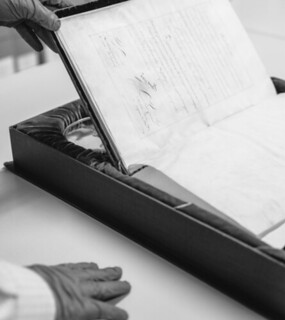 In "the vault" in NARA's neoclassical D.C. headquarters, Wright and I gazed upon the Louisiana Purchase, a striking black volume bedazzled in gold, like a pair of pants worthy of Prince, one of the Louisiana Territory's greatest sons. When Napoleon, strapped for cash, sold control of more than 800,000 square miles to the United States in 1803 — a preposterous, nearly ungovernable stretch of real estate that would encompass the present-day boundaries of France, Spain, Germany, Italy, Britain, Portugal, the Netherlands and Switzerland — he cursed us as a people with a perpetual state of alienation (and North Dakota). Conrad is up near the Louisiana Territory's northwestern edge, just east of the Continental Divide. We flipped to the fading signature that bequeathed to Wright a birthplace as well as her life's work shrinking down all that distance: "Bonaparte."
In "the vault" in NARA's neoclassical D.C. headquarters, Wright and I gazed upon the Louisiana Purchase, a striking black volume bedazzled in gold, like a pair of pants worthy of Prince, one of the Louisiana Territory's greatest sons. When Napoleon, strapped for cash, sold control of more than 800,000 square miles to the United States in 1803 — a preposterous, nearly ungovernable stretch of real estate that would encompass the present-day boundaries of France, Spain, Germany, Italy, Britain, Portugal, the Netherlands and Switzerland — he cursed us as a people with a perpetual state of alienation (and North Dakota). Conrad is up near the Louisiana Territory's northwestern edge, just east of the Continental Divide. We flipped to the fading signature that bequeathed to Wright a birthplace as well as her life's work shrinking down all that distance: "Bonaparte."
In the NARA vault, we also glanced at the Homestead Act, signed by Abraham Lincoln in 1862 — a leg up for future settlers like her Norwegian American grandfather and an irrevocable setback for the continent's original inhabitants. If National Park Service estimates are correct, more than one-fourth of all Americans descend from homesteaders, including both of Montana's U.S. senators, Democrat Jon Tester and Republican Steve Daines.
As NARA's first chief innovation officer, Wright explained, "my role has been to ignite a culture of innovation across the agency, to nurture new ideas and to incorporate emerging technologies in order to better share our records with the public. For example, we worked with Wikipedia to put thousands of digital copies of our records on their website. This resulted in billions of views by people who may never visit the NARA website, let alone one of our buildings."
Roger Burdette adds:
"To me, the greater value is in digitizing (and where necessary transcribing) the routine government business documents. The "flashy" items such as the Louisiana Purchase are often end-products --- the results. The routine materials let us see how these products developed and were finalized.
"With US Mint materials, NNP's digitization programs are the first and only extensive attempt to dig into historical background of well-known events, and to expose the unknown to examination. The results are that one no longer has to sift through other peoples' opinions to learn what happened."
That looks like a medal in the box holding the Louisiana Purchase. Can anyone identify it for us? Where and when was it struck? -Editor
To read the complete article, see:
The Equalizer
(https://www.washingtonpost.com/opinions/interactive/2024/sarah-vowell-national-archives-digitization-records-smartphones/)







